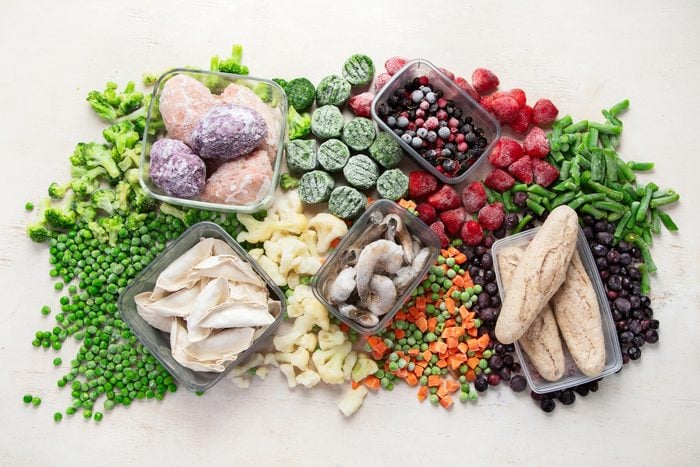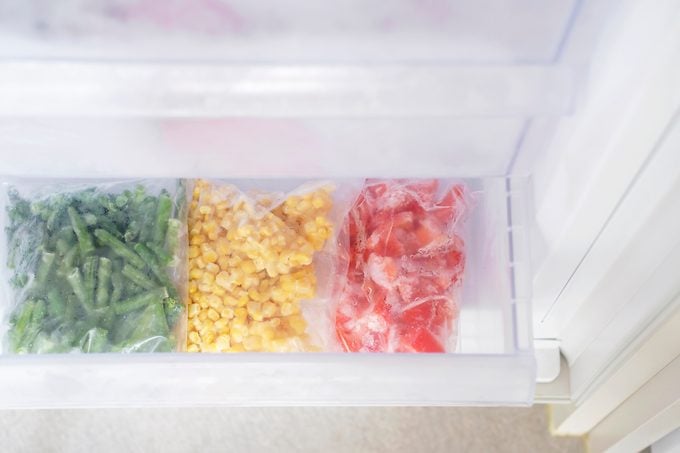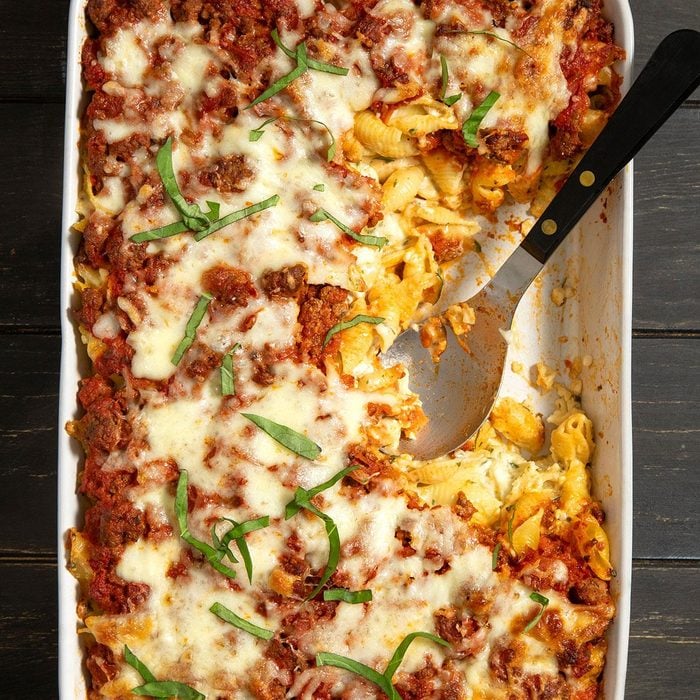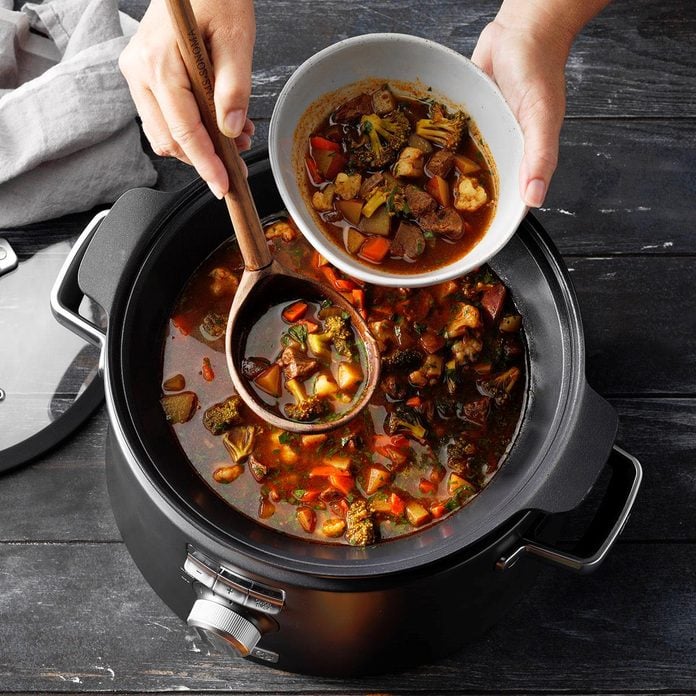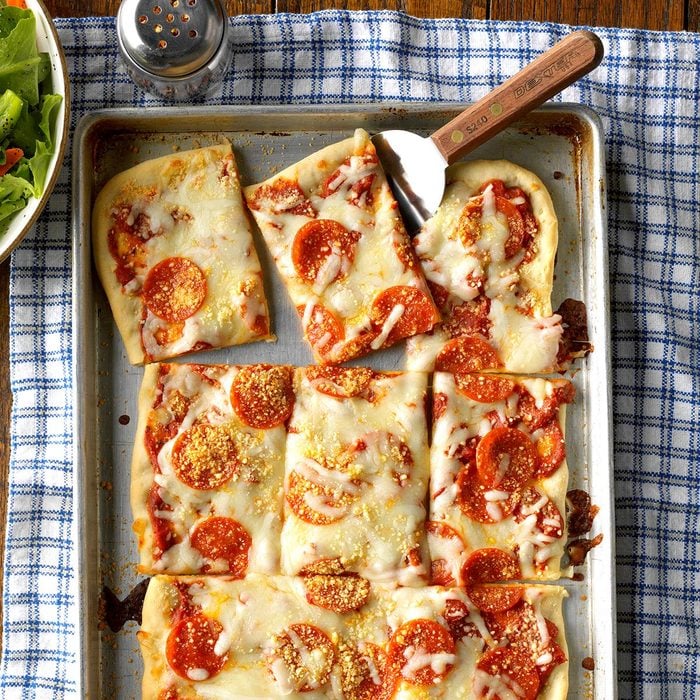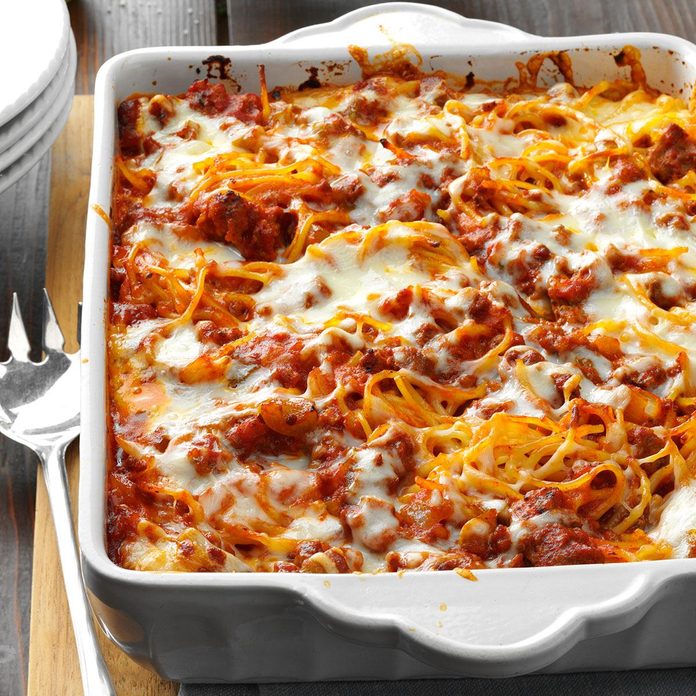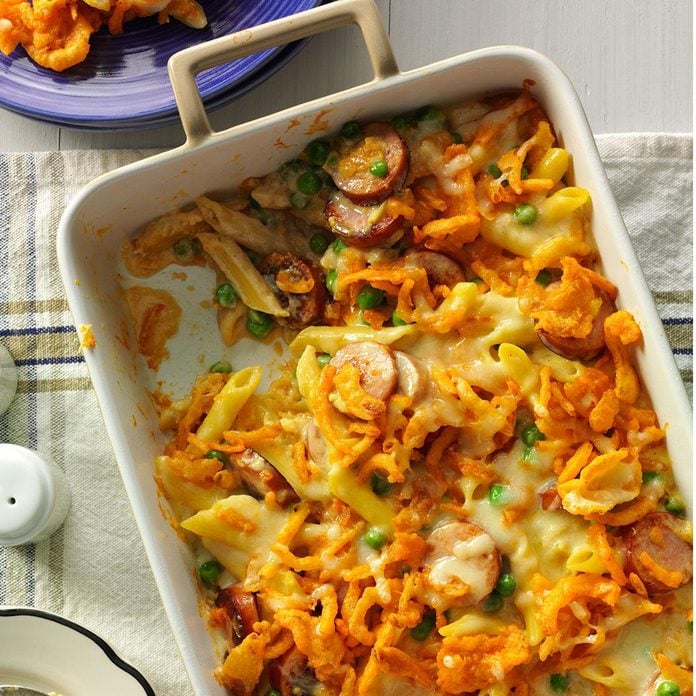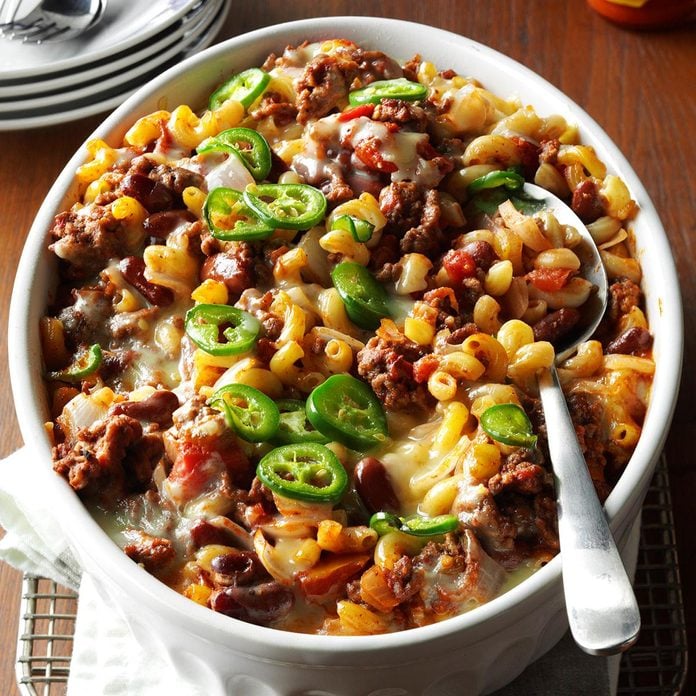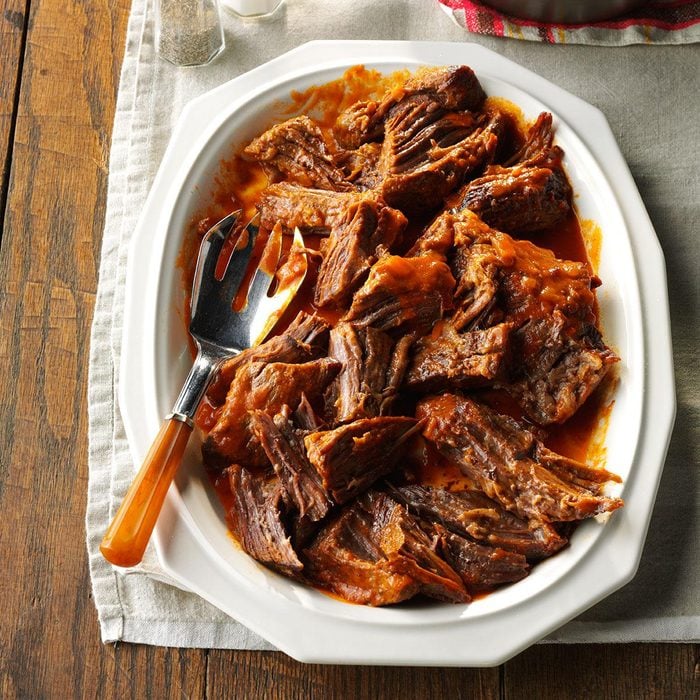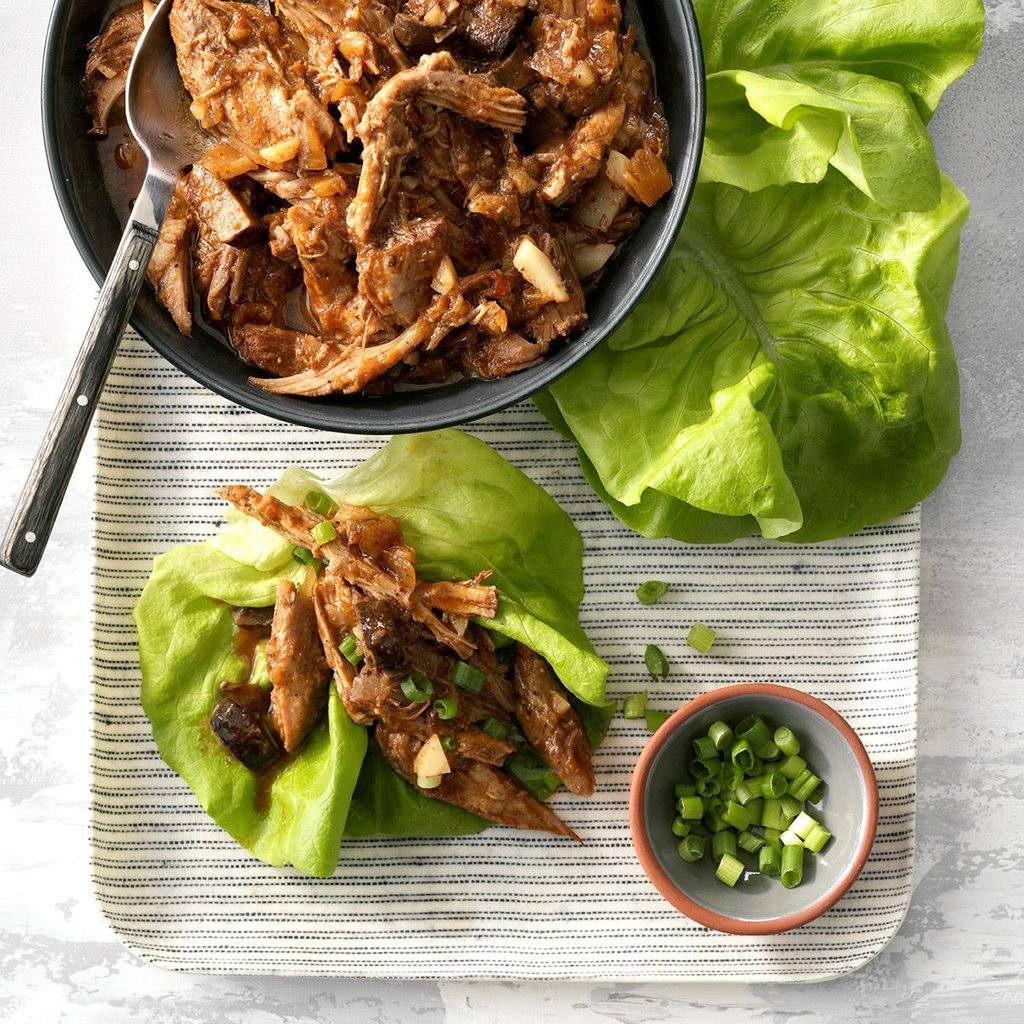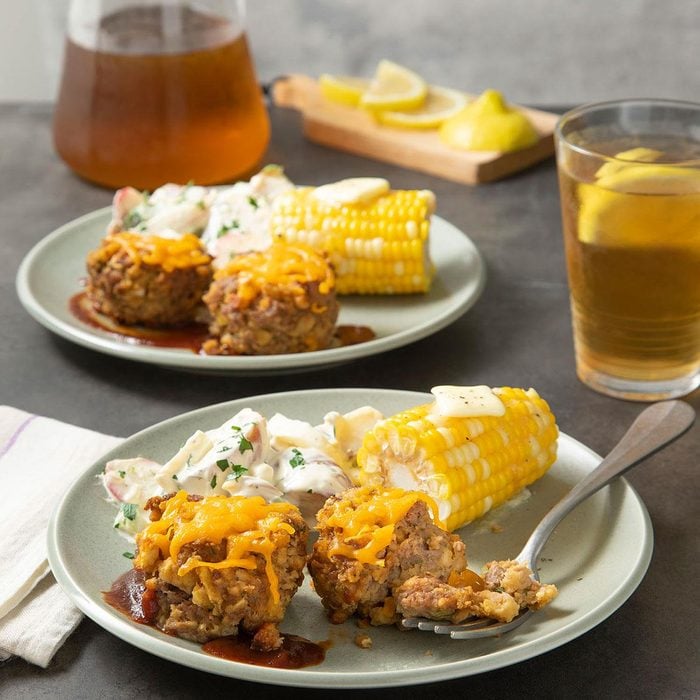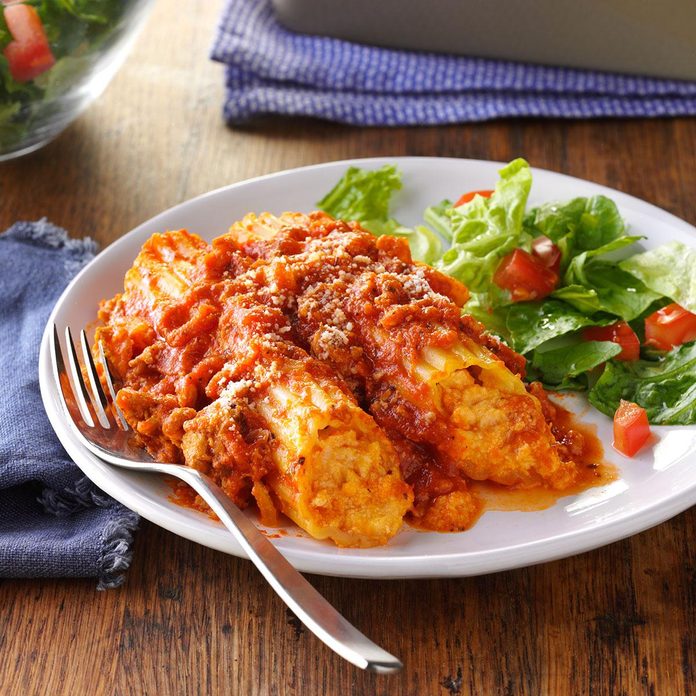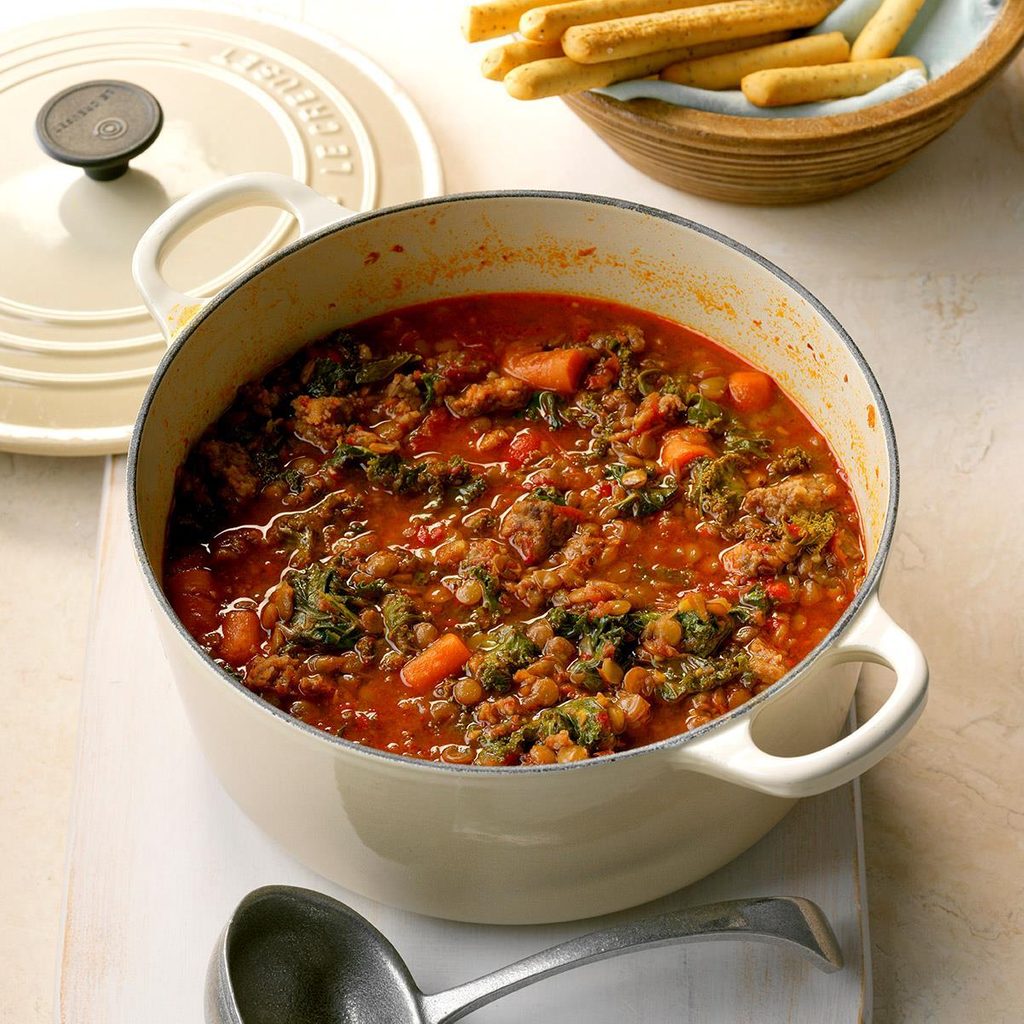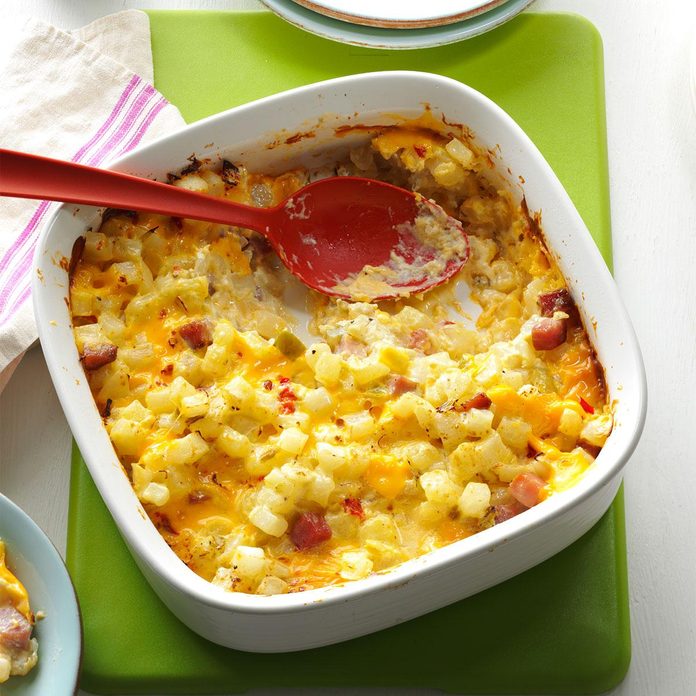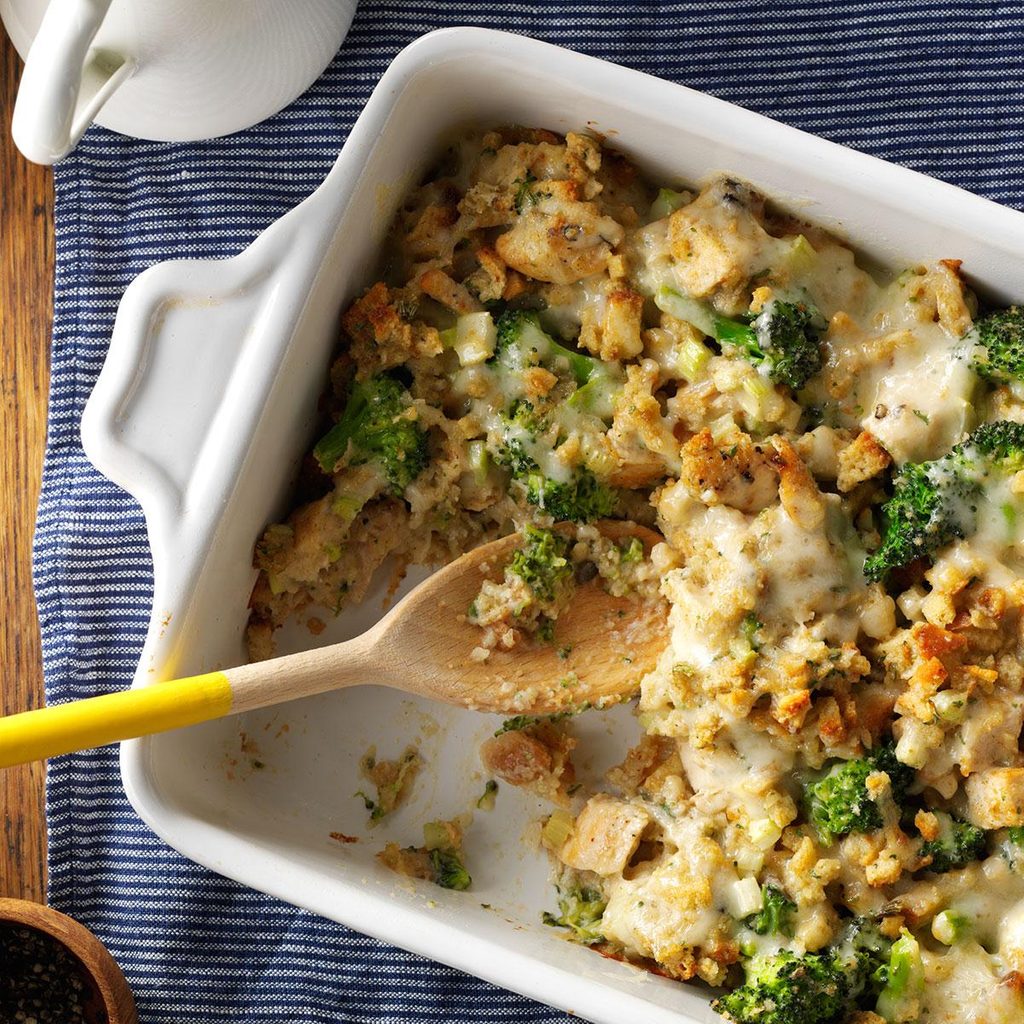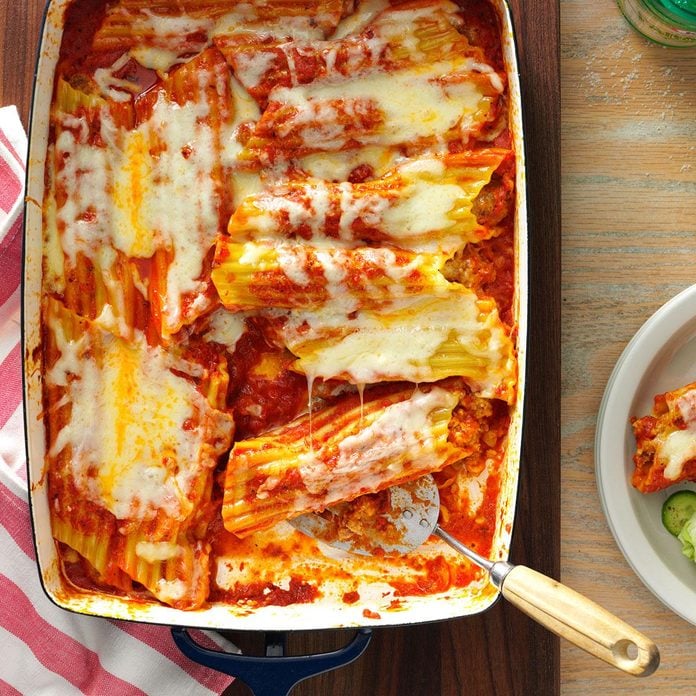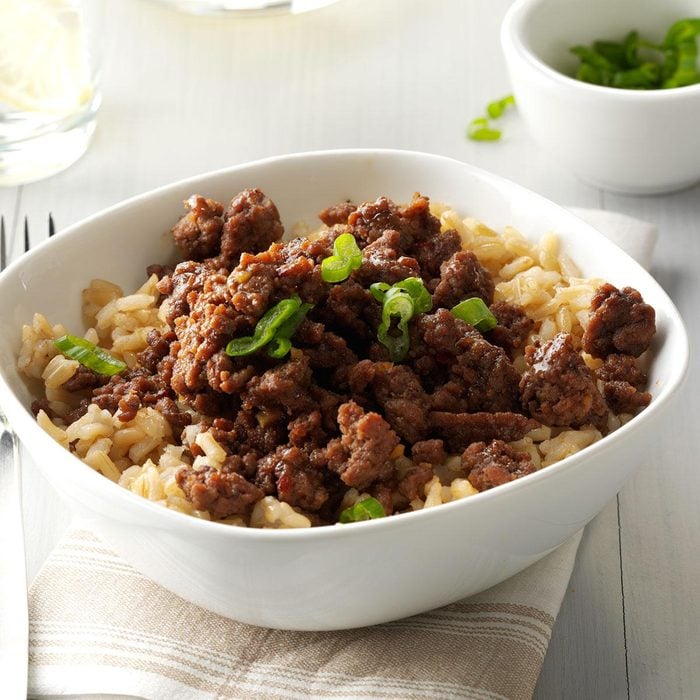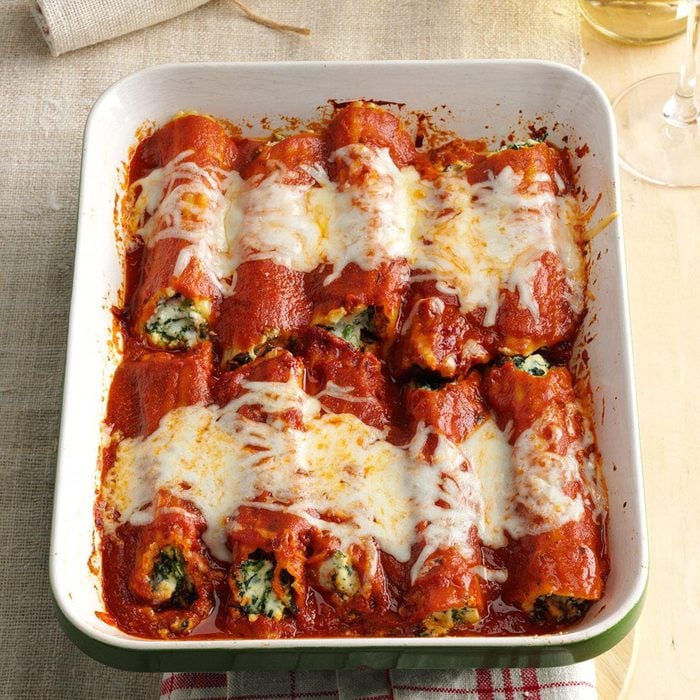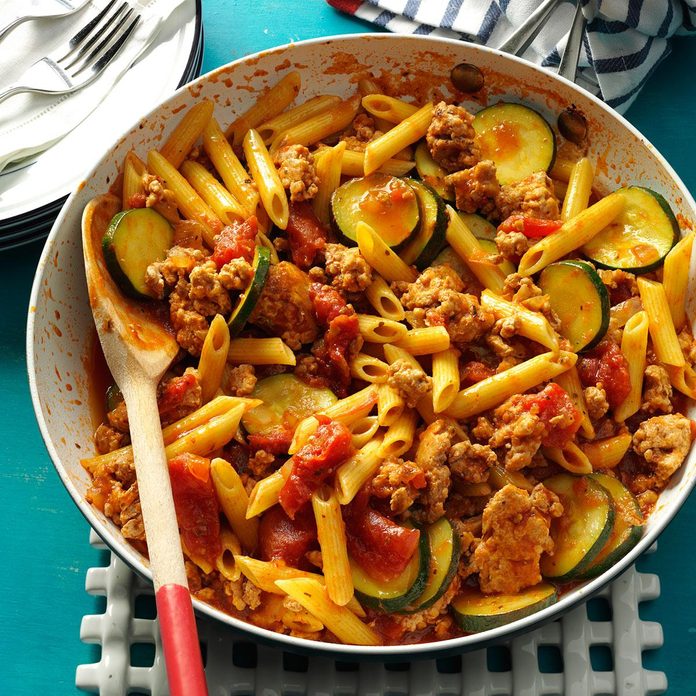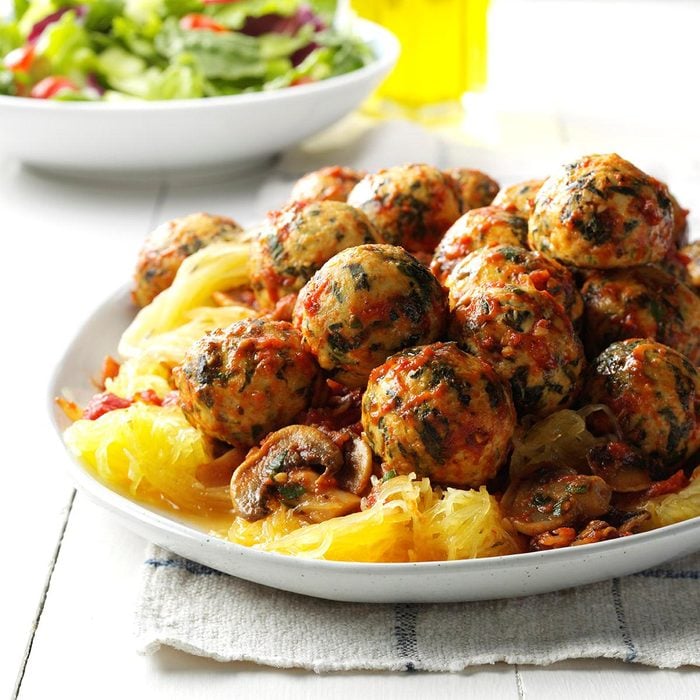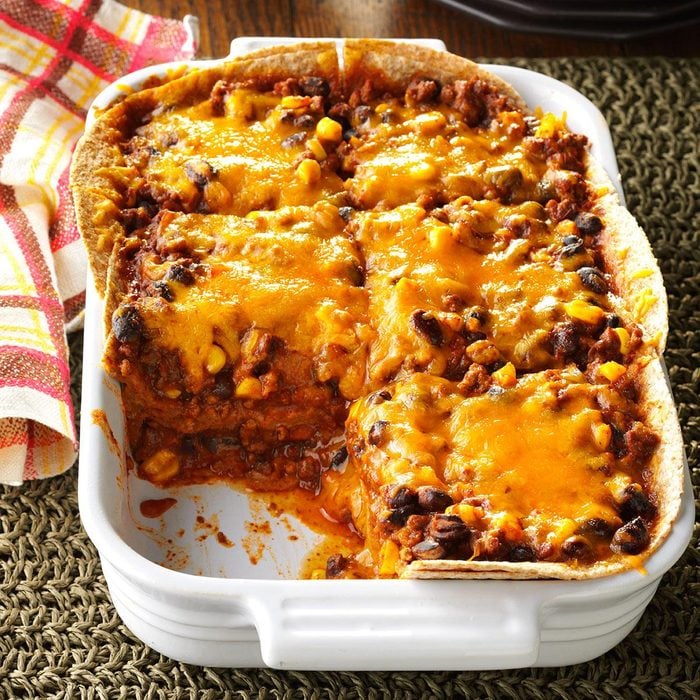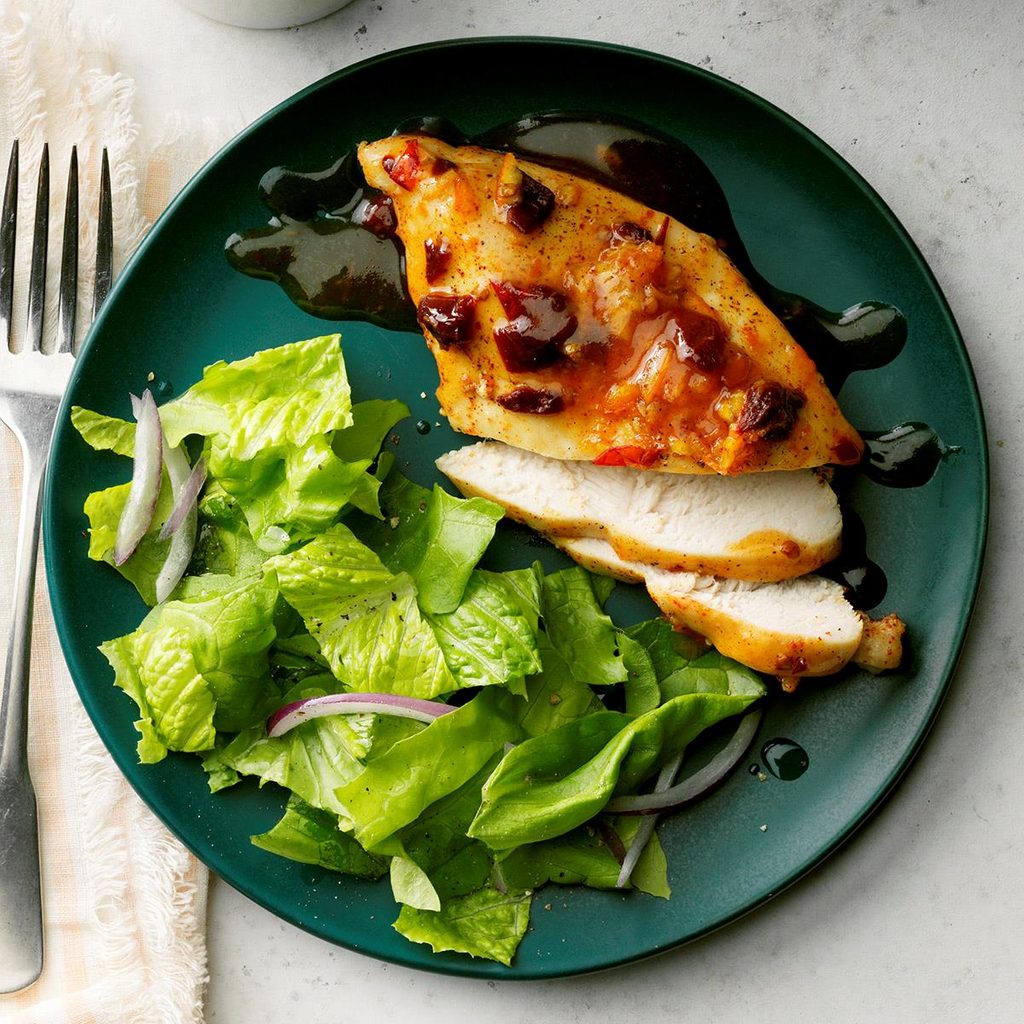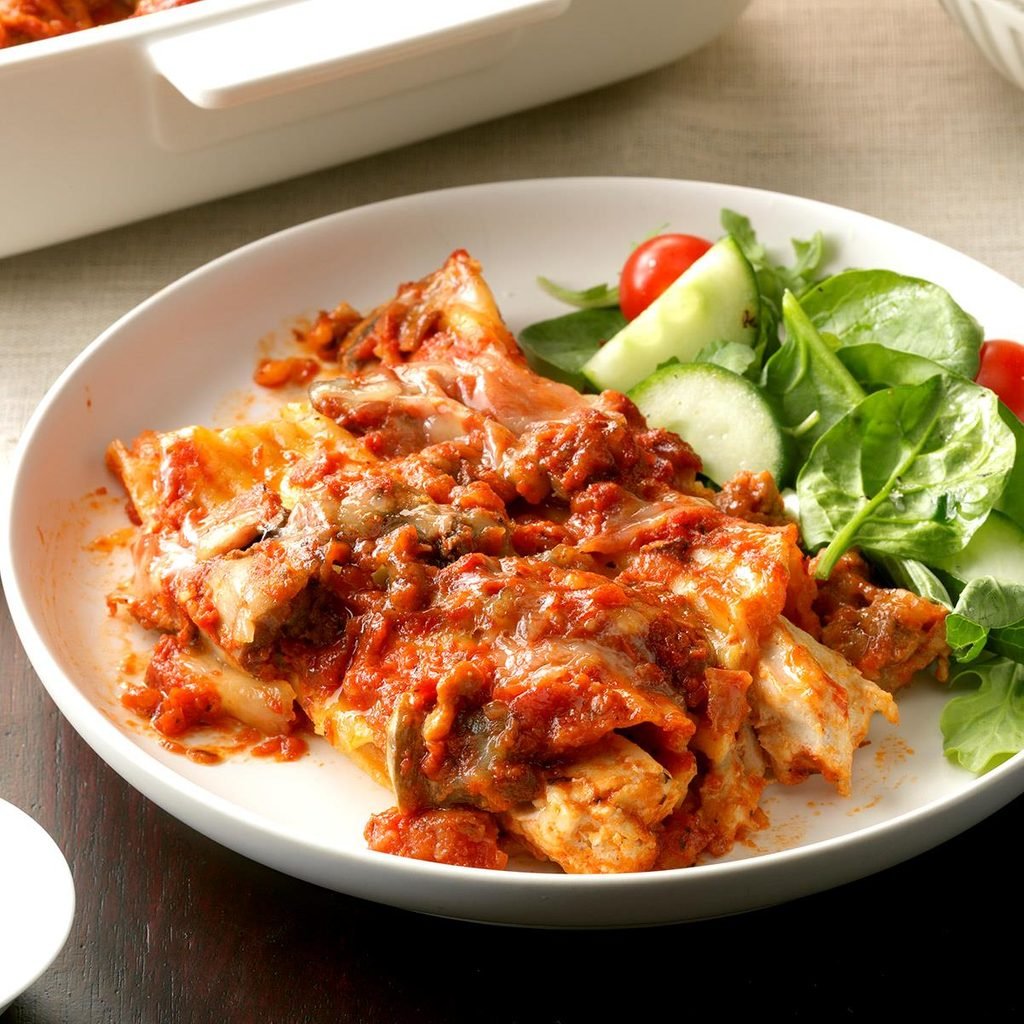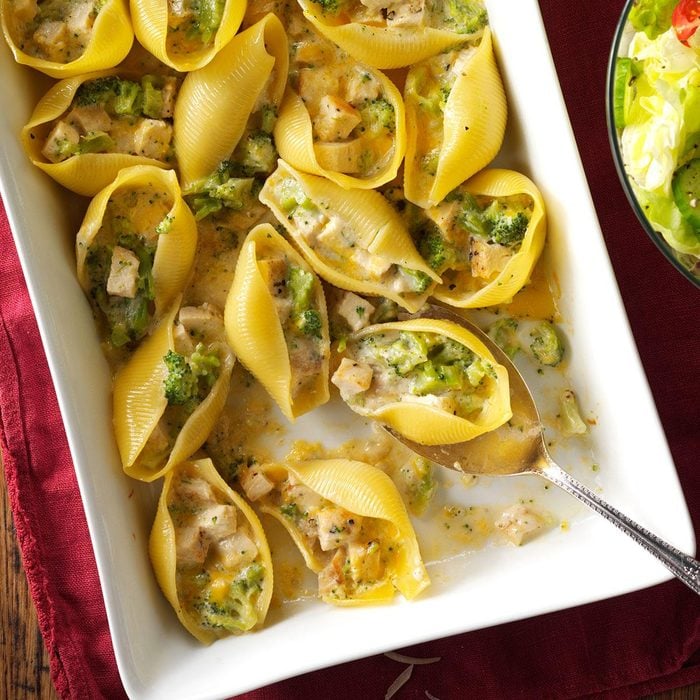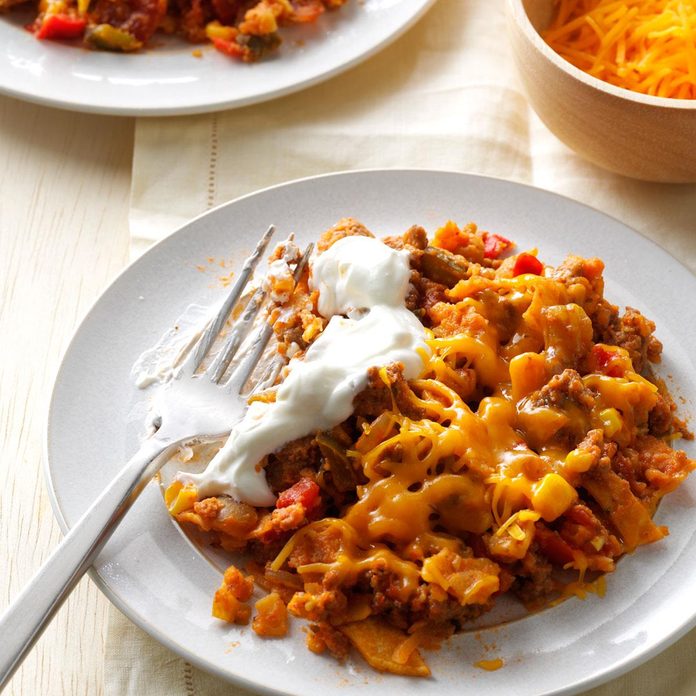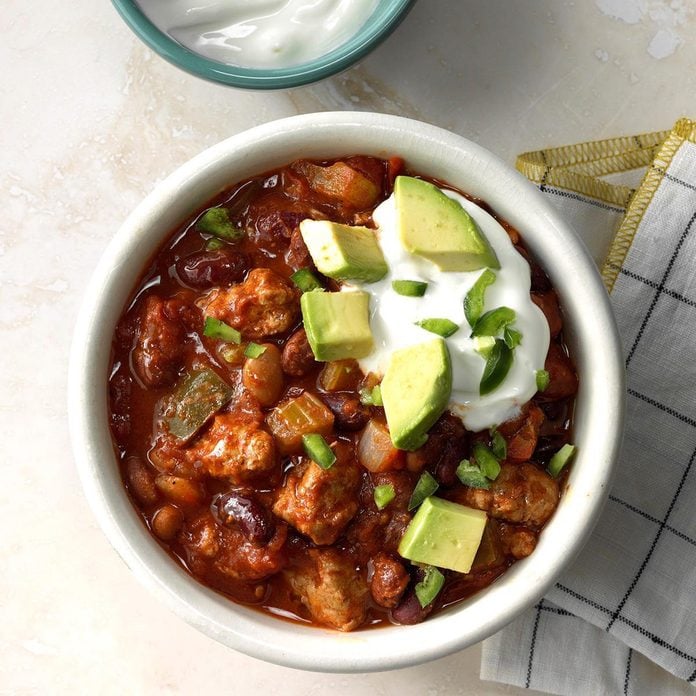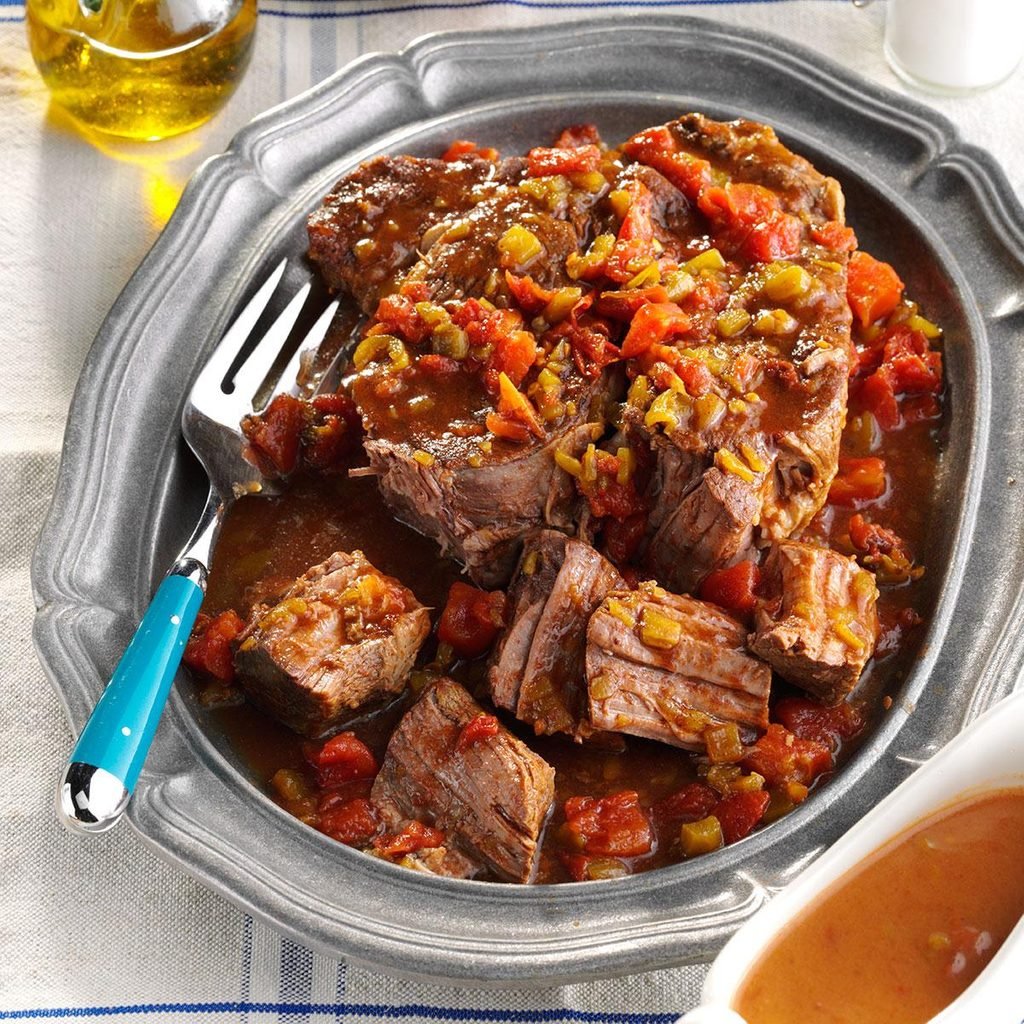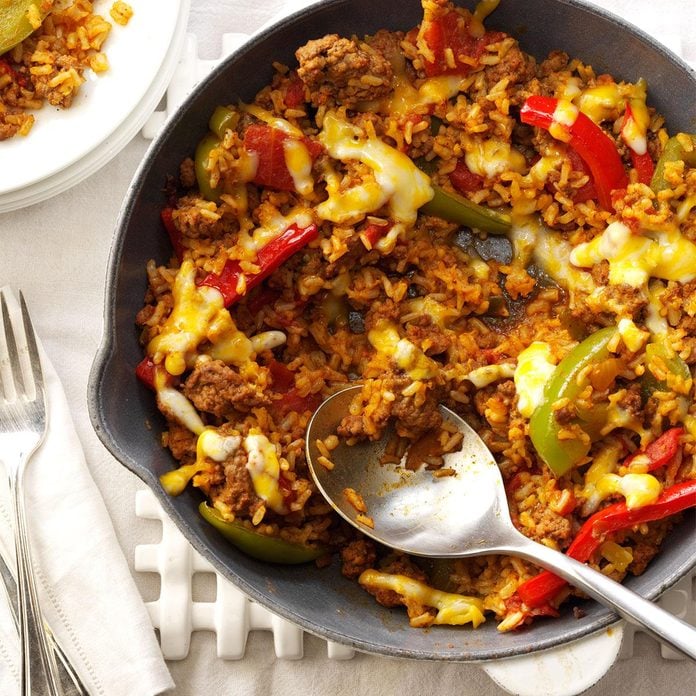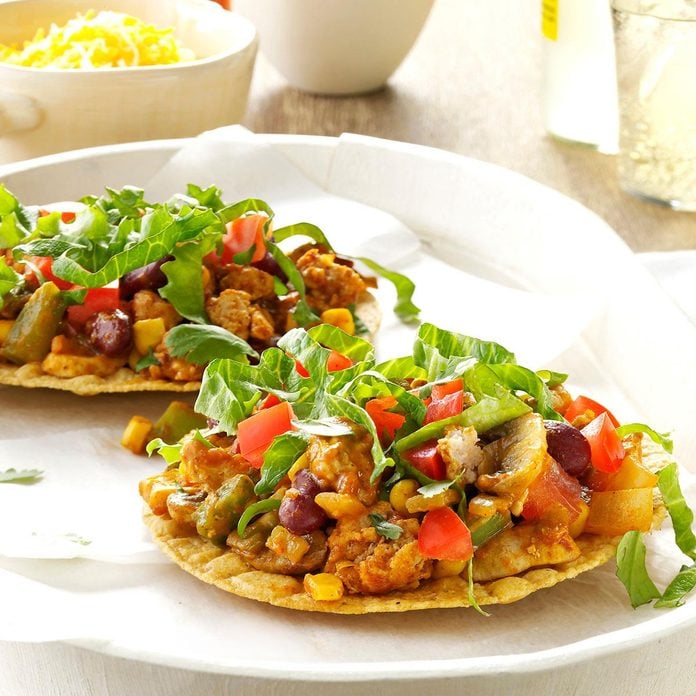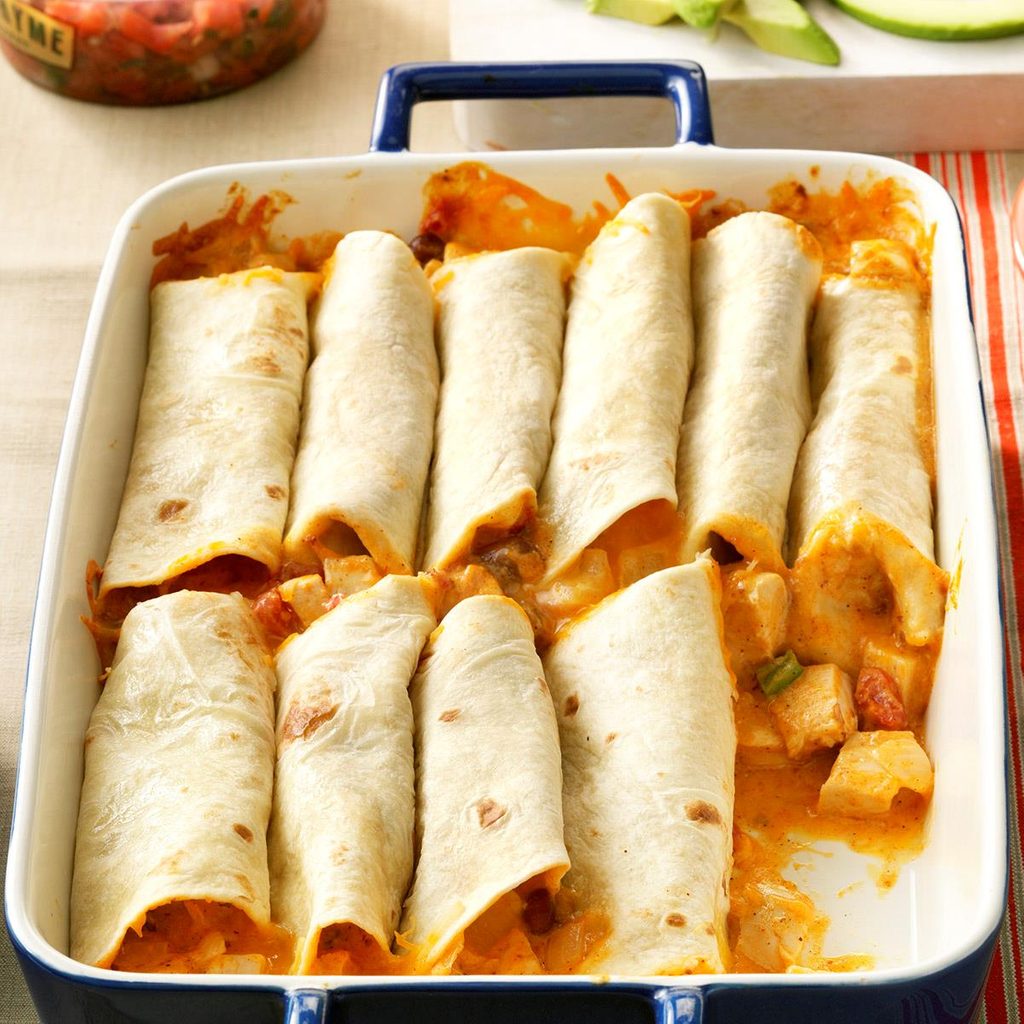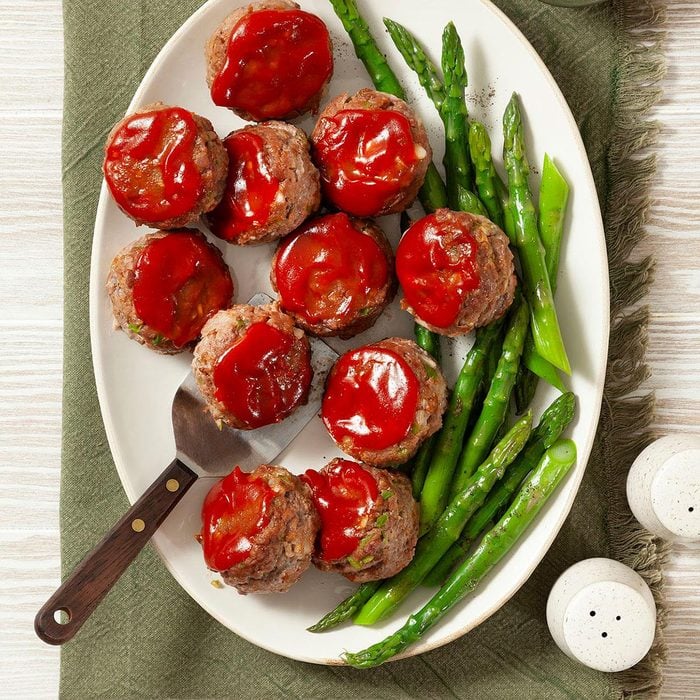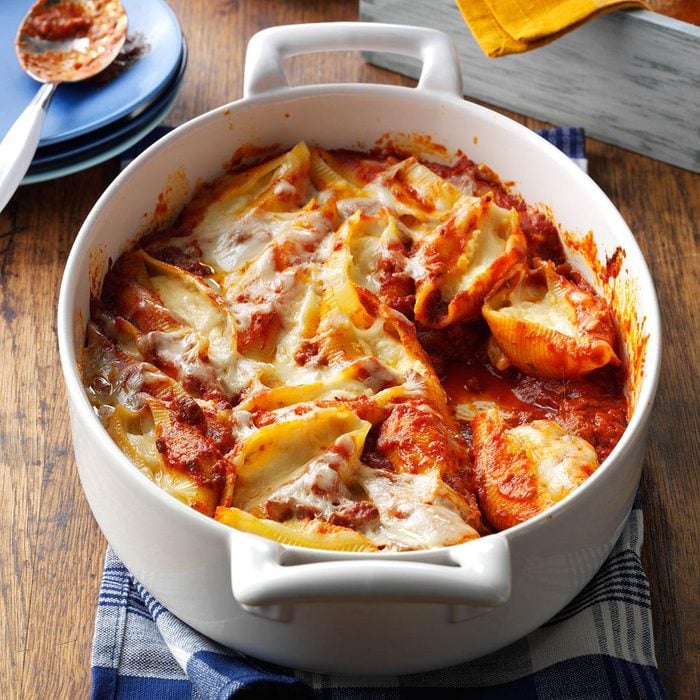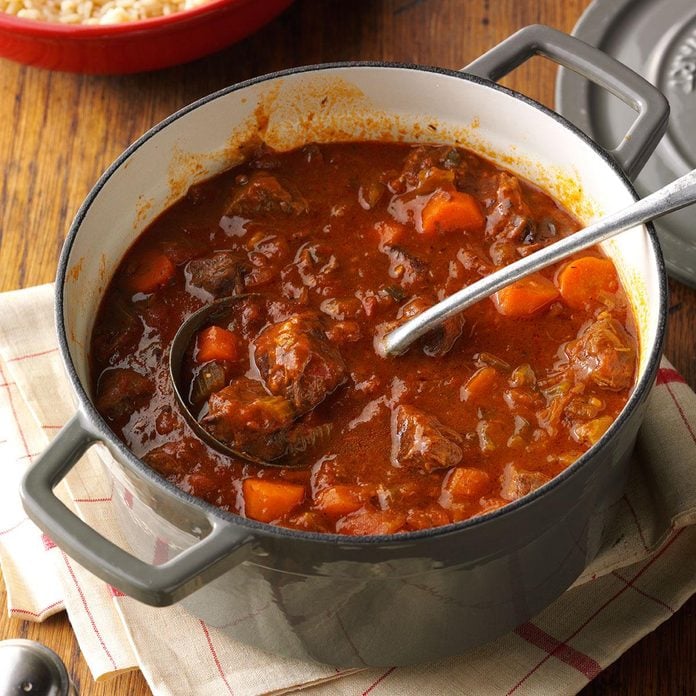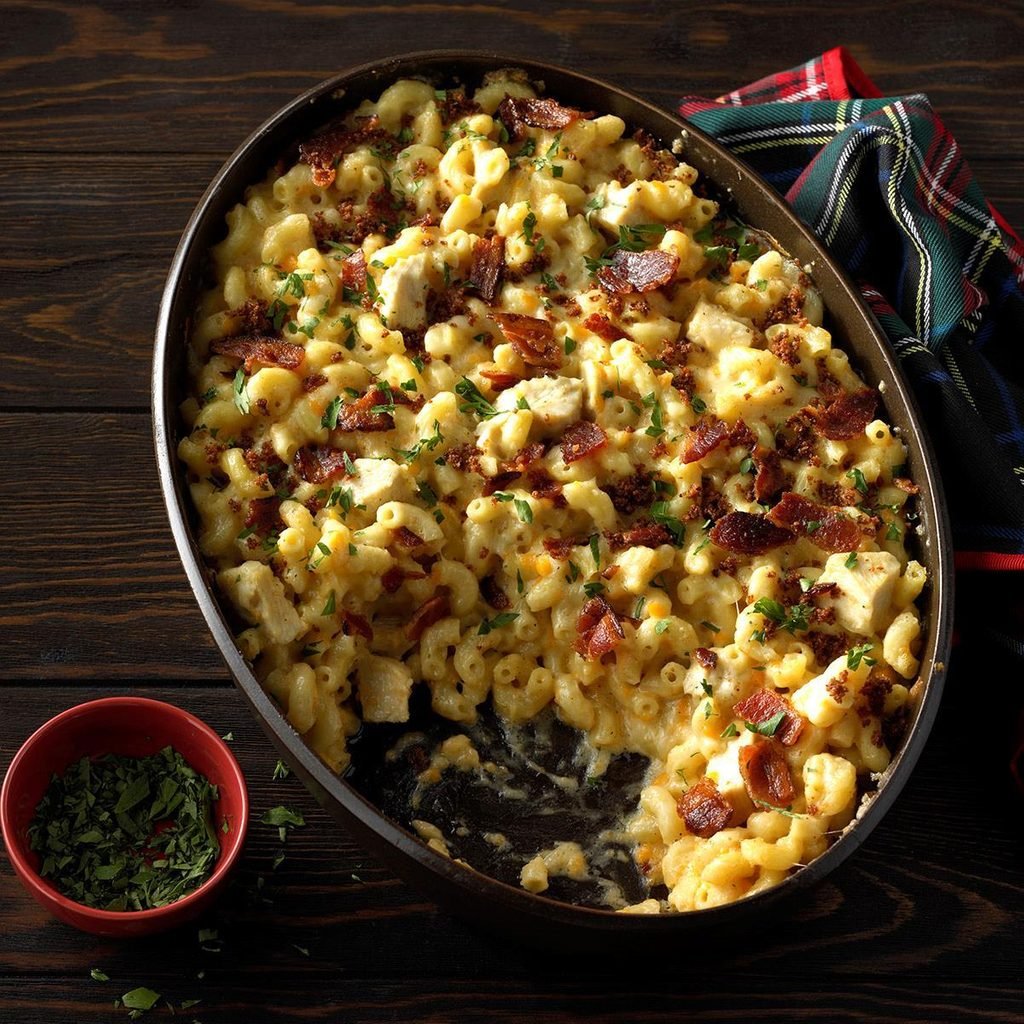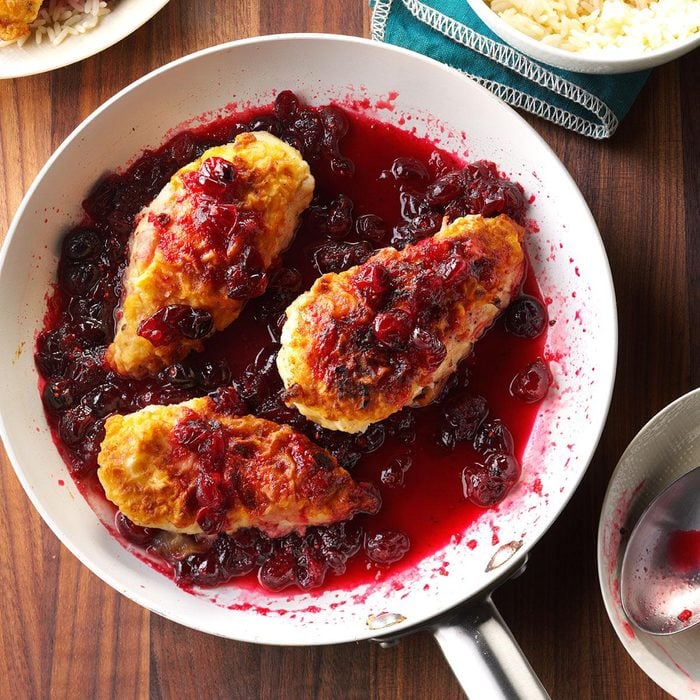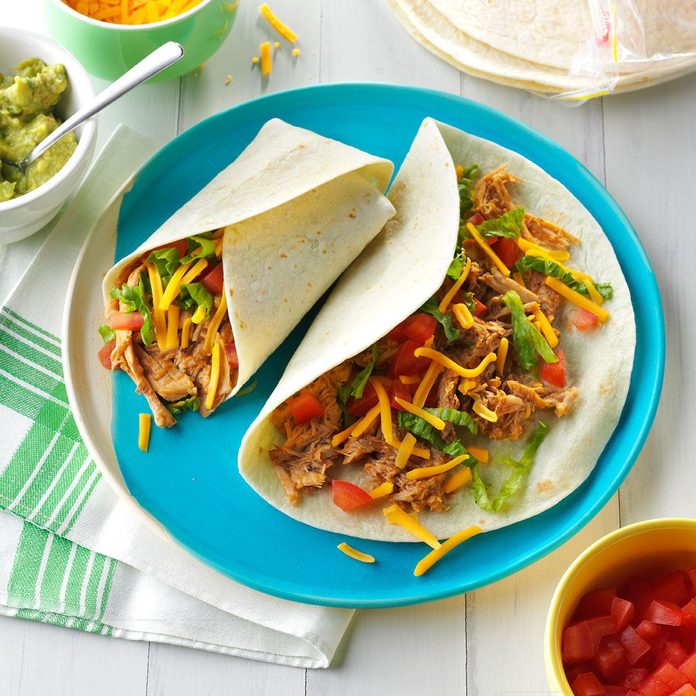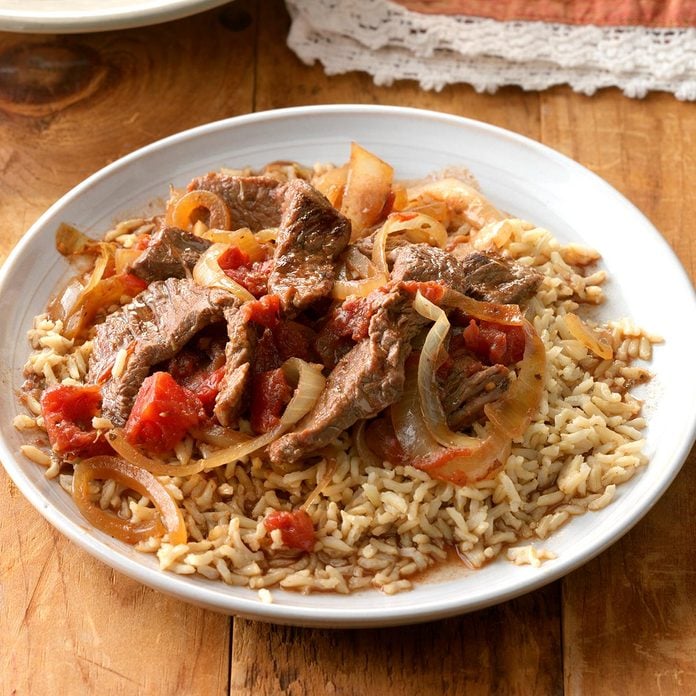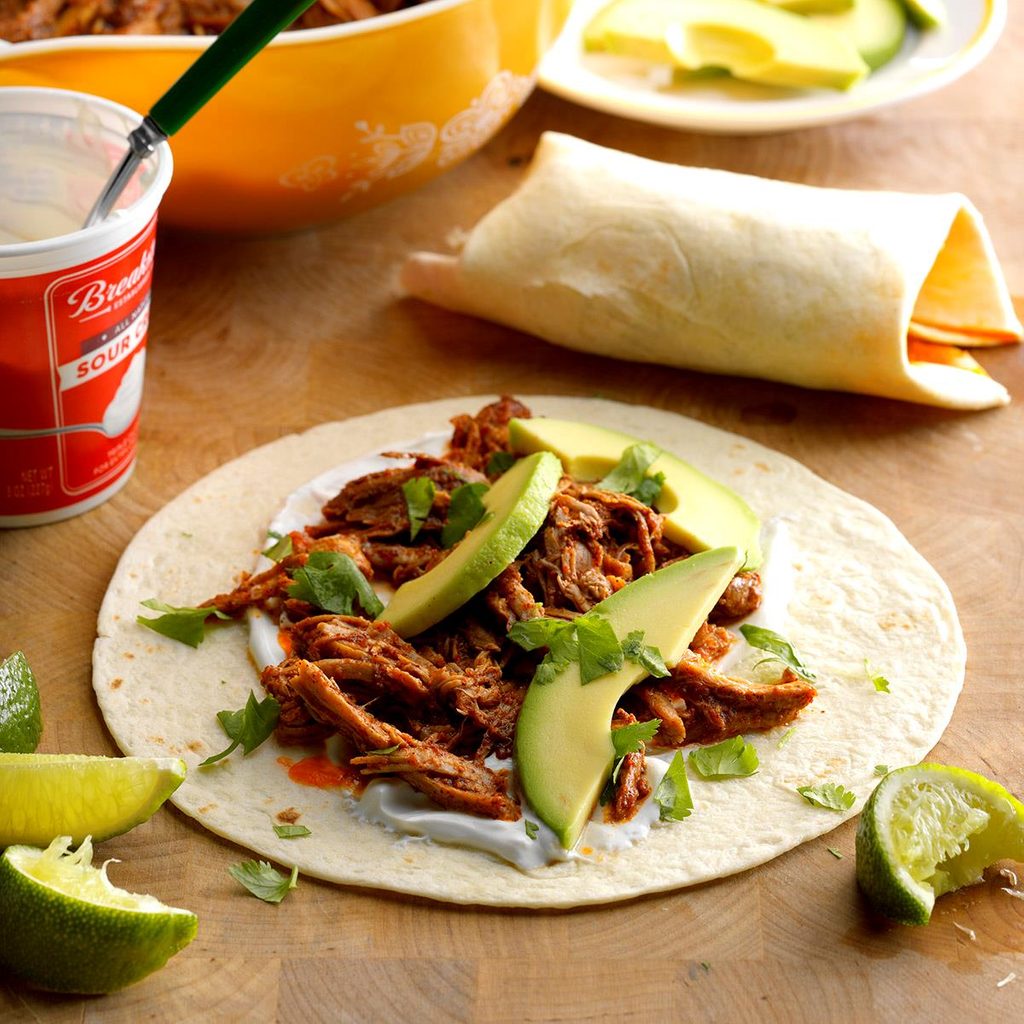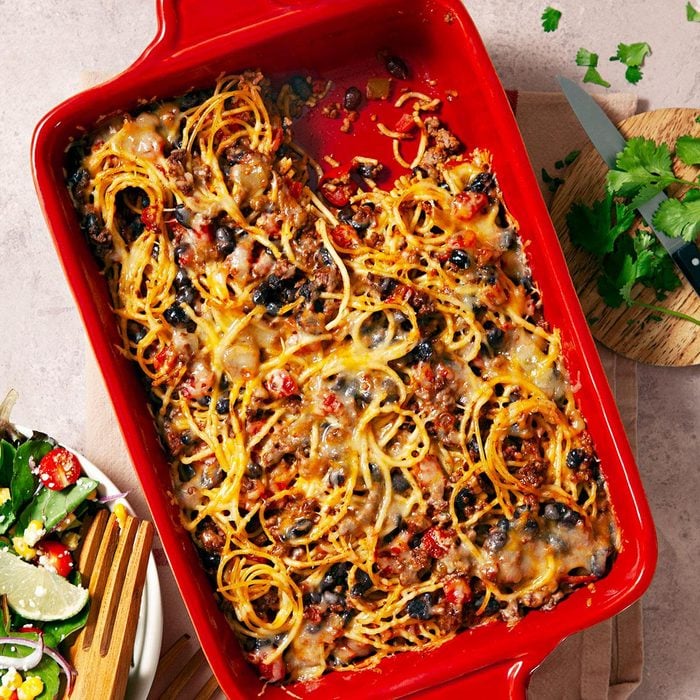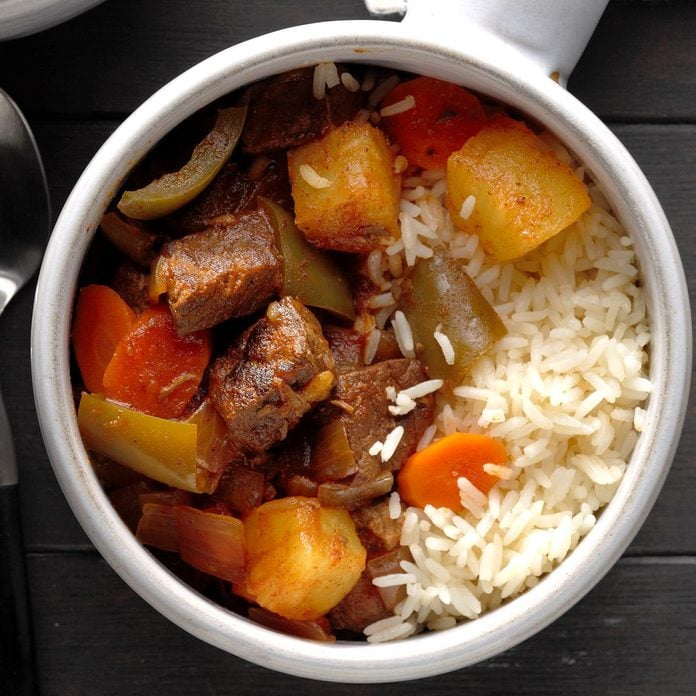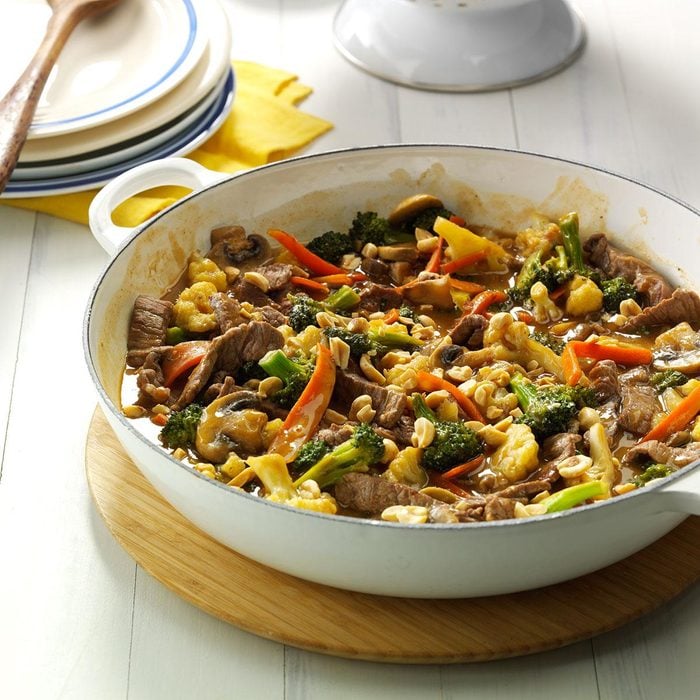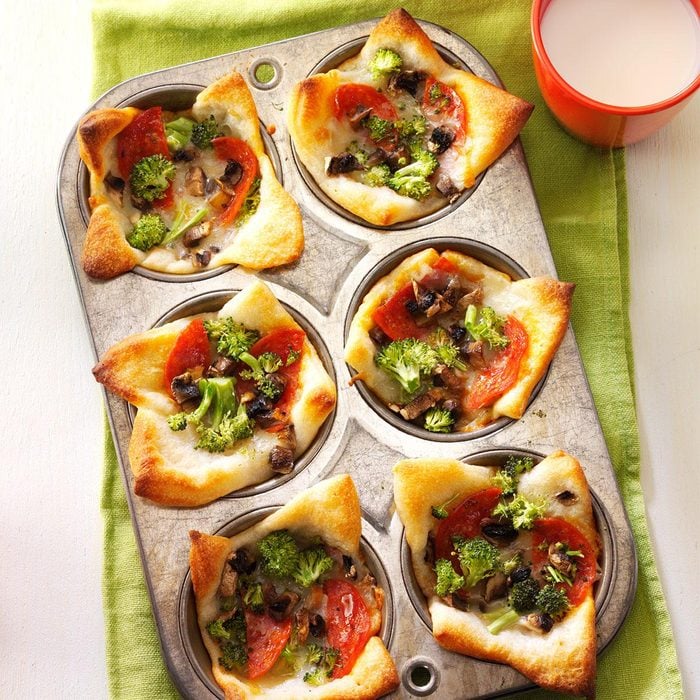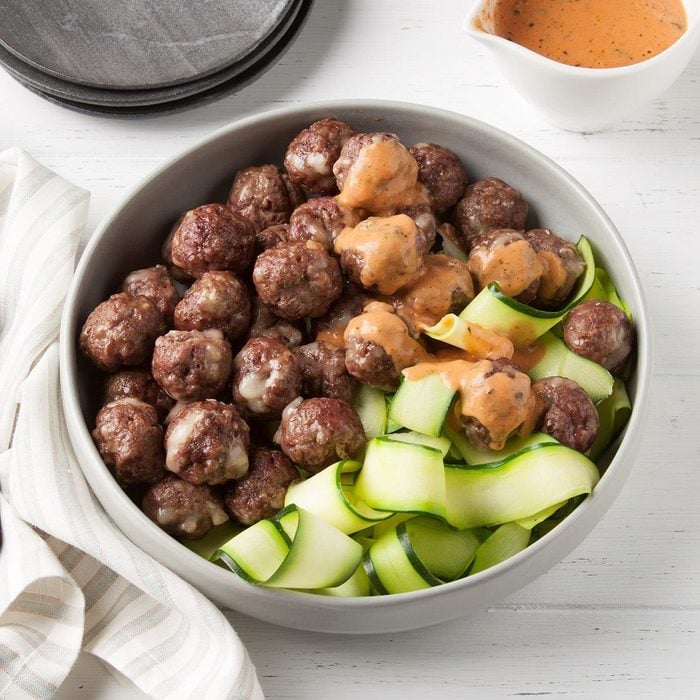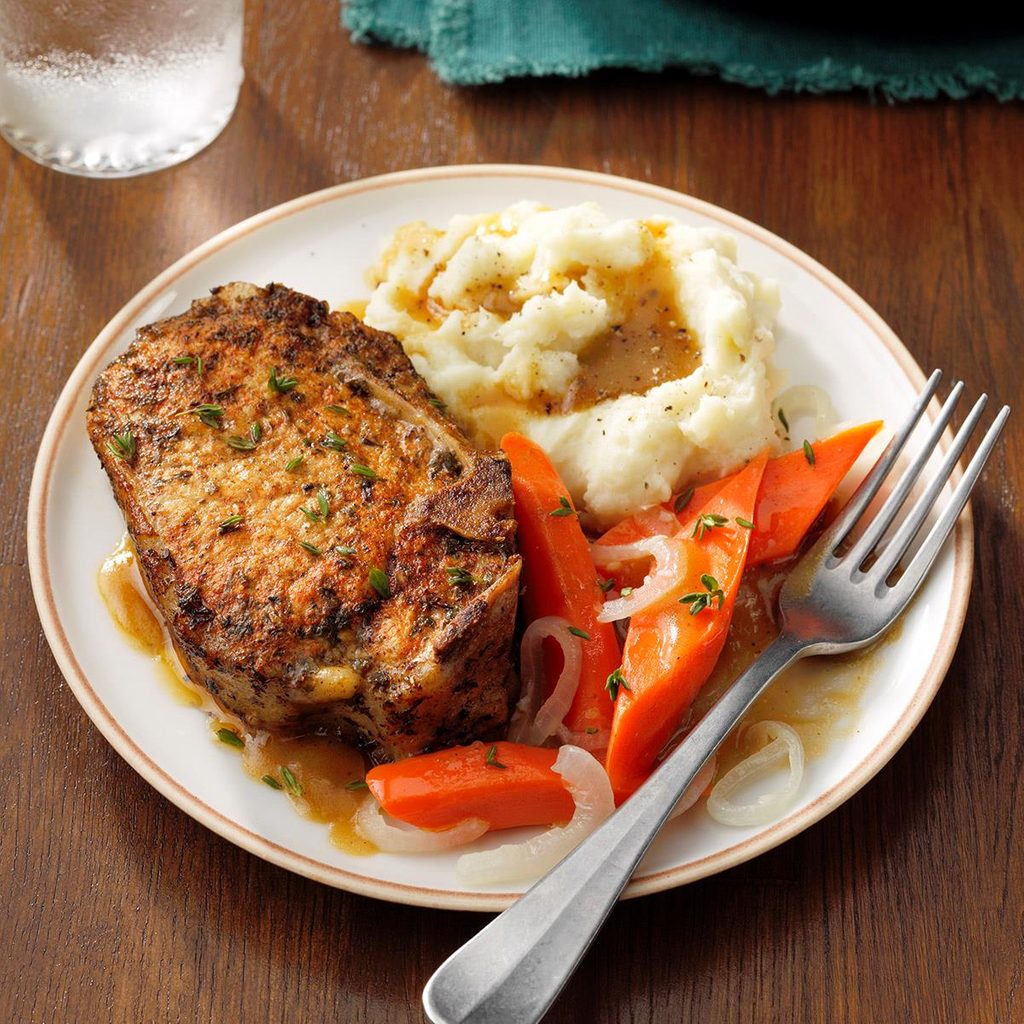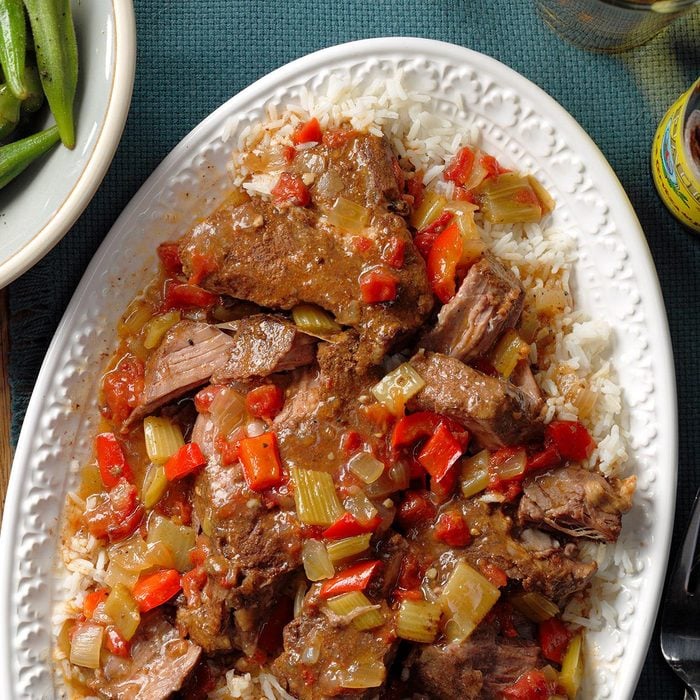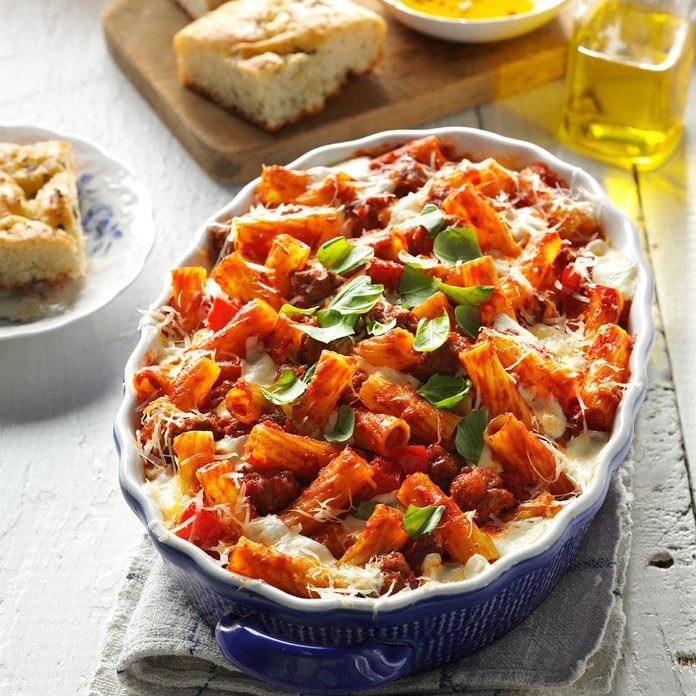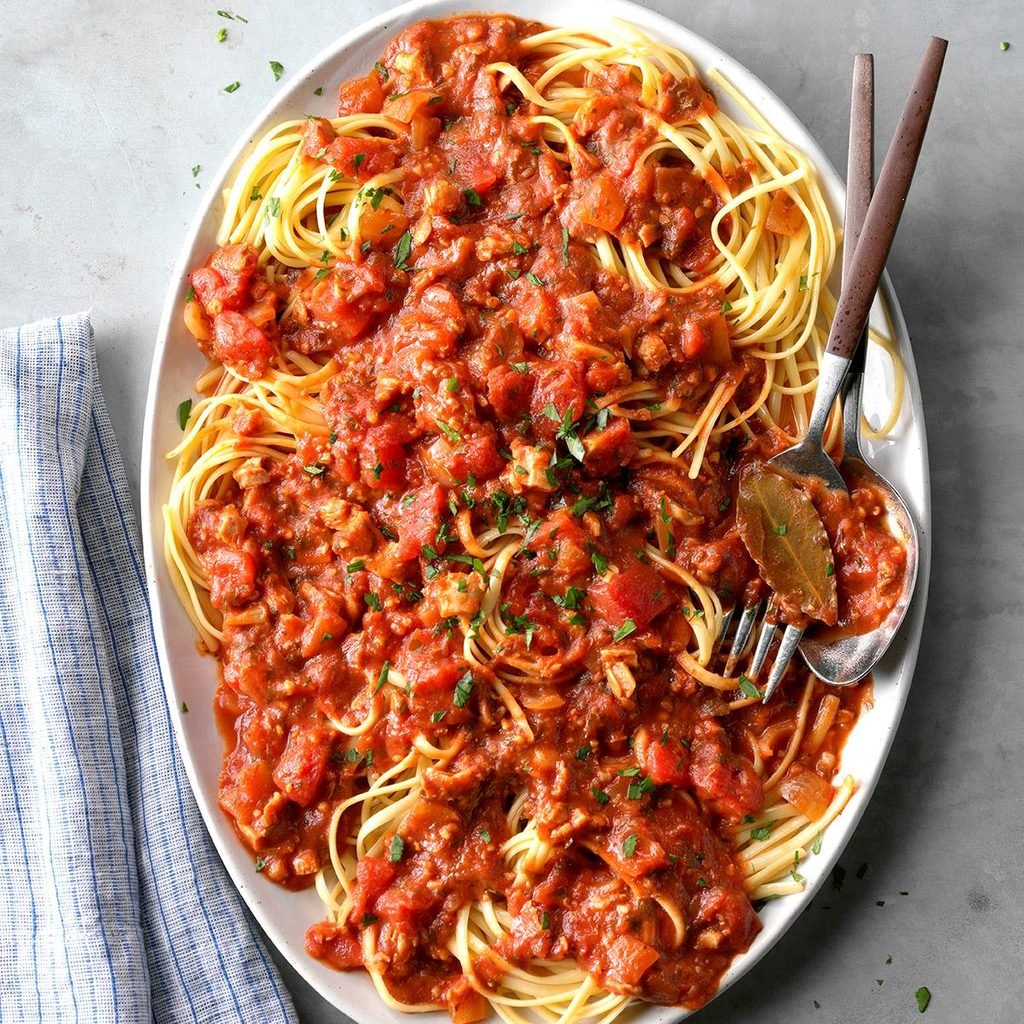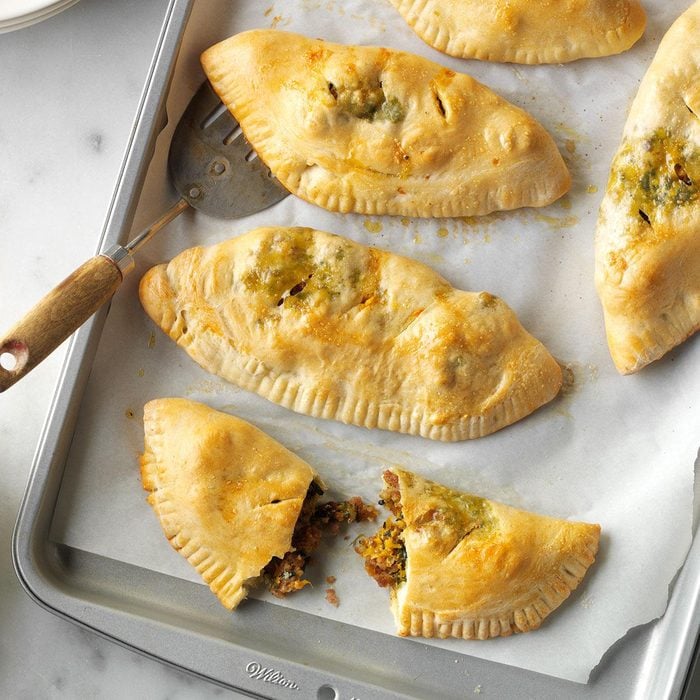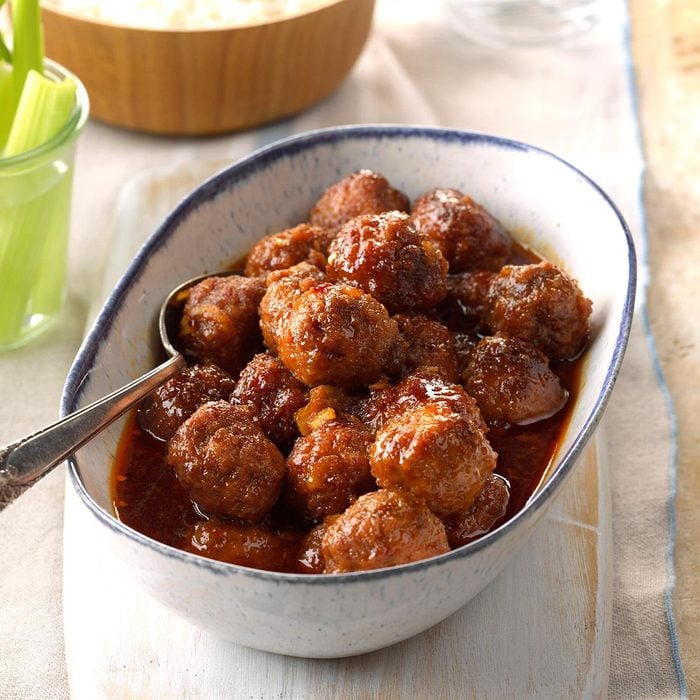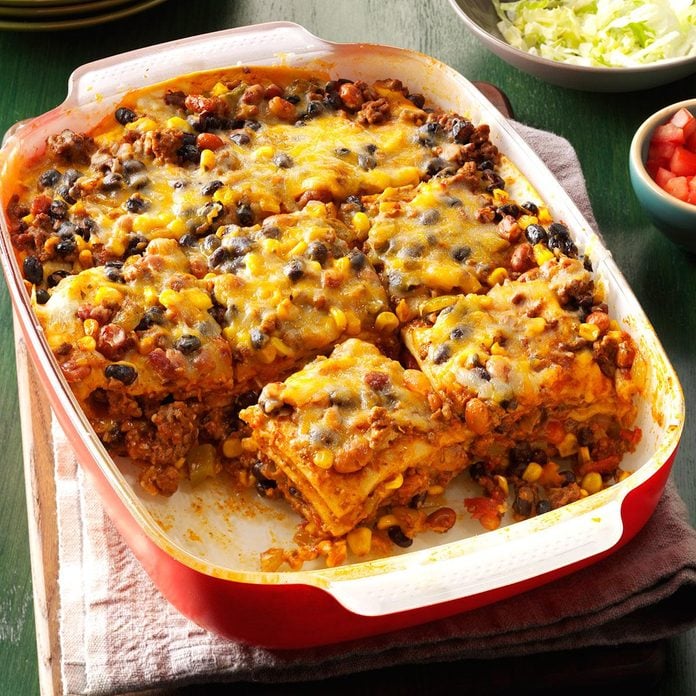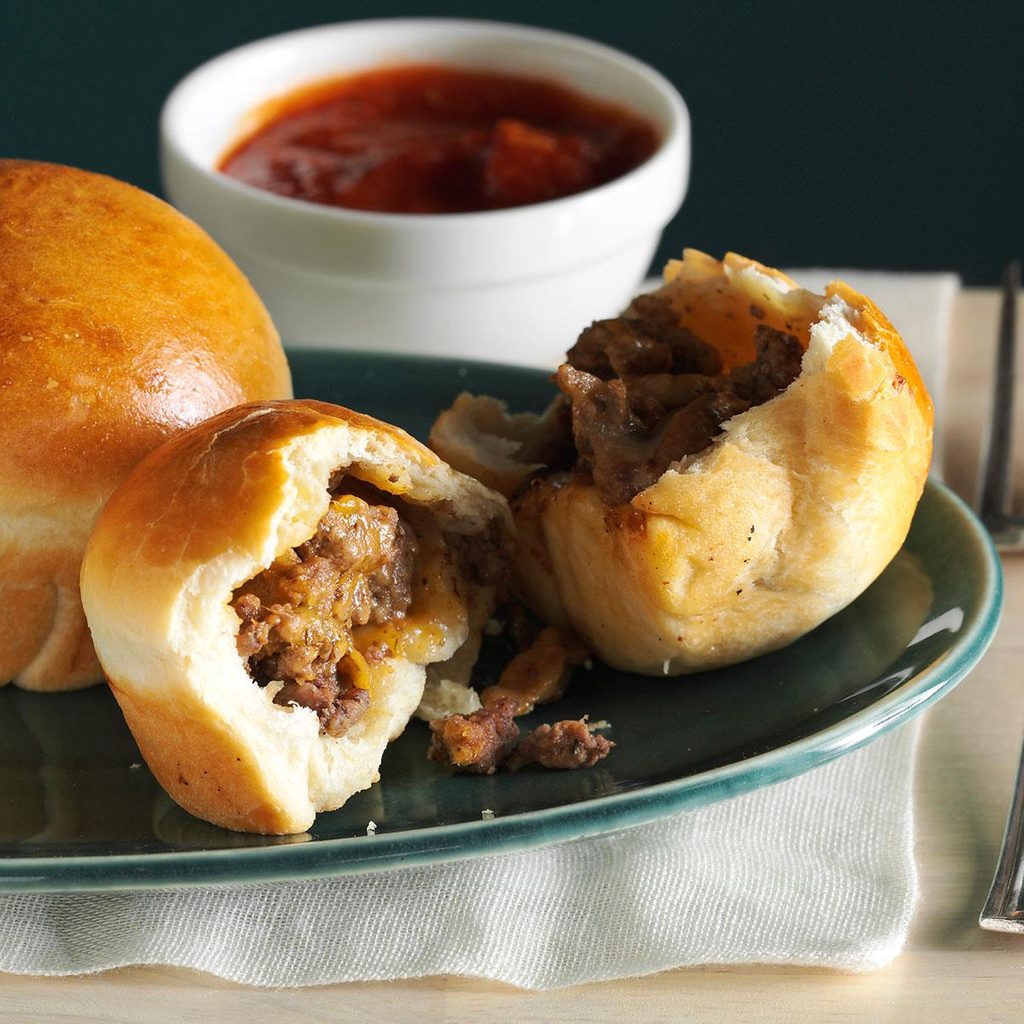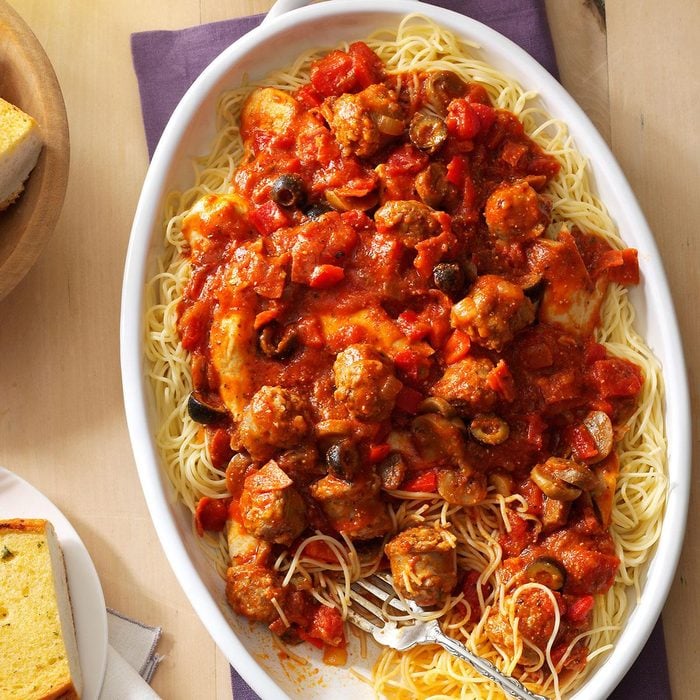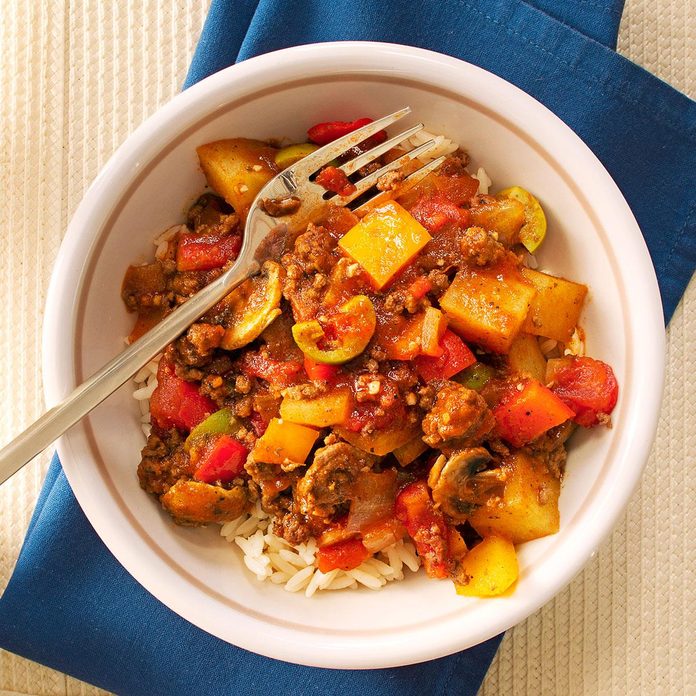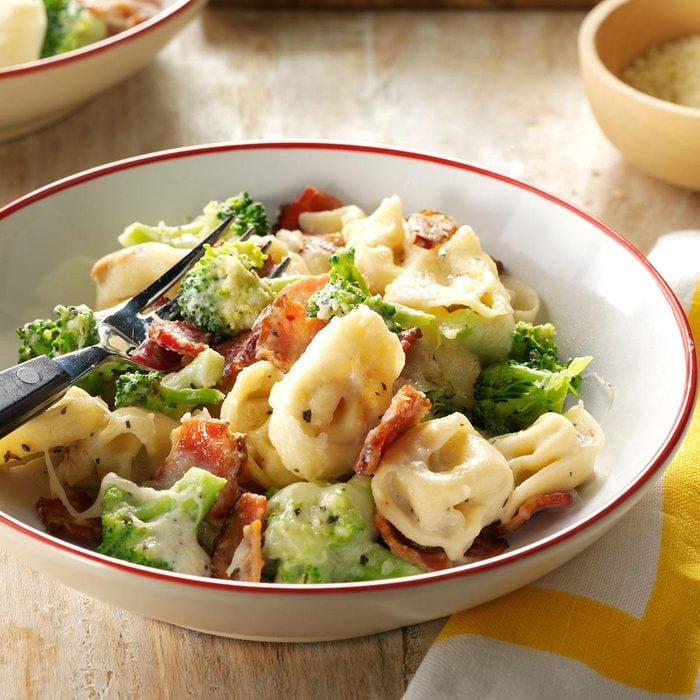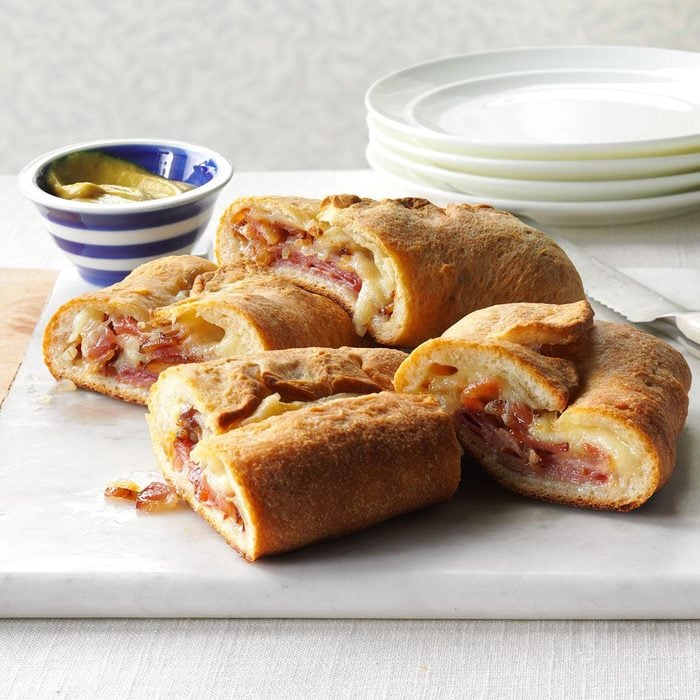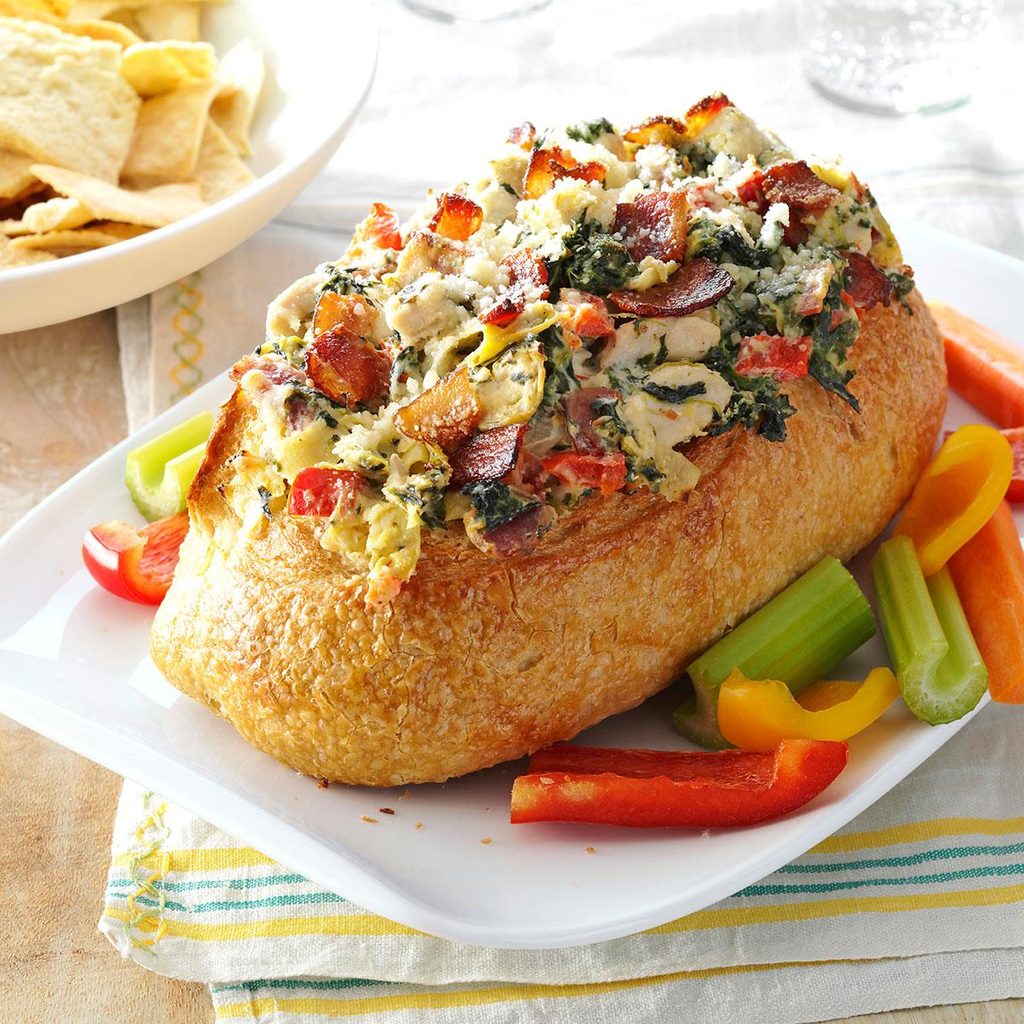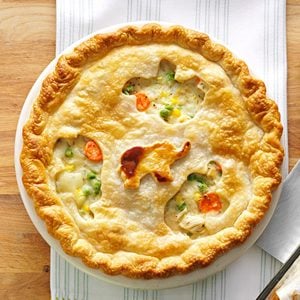 Taste of Home
Taste of Home
Chock-full of poultry, potatoes, peas and corn, this recipe for easy chicken pot pie makes two golden pies, so you can serve one at supper and save the other in the freezer for a busy night. This is the best chicken potpie recipe to have on hand when company comes over. —Karen Johnson, Bakersfield, California.
Freezer Meal
Prep Tip: For the best results, freeze unbaked chicken potpies. That way, the pies will be able to cook through without burning the crust. Get more tips for
freezing food.
Get Recipe
Lasagna CasseroleAll the traditional flavor of lasagna, with none of the fuss. We've simplified the layers in this lasagna casserole so the dish comes together more quickly.
Steakhouse SoupEnjoy a steak dinner in a bowl with this super simple, hearty steak soup. Because of the chili powder and cayenne pepper, it packs a little heat, but the recipe can easily be adjusted if you’re cooking for young ones. —Erica Schmidt, Kansas City, Kansas.
Freezer Meal Prep Tip: To keep your food safe, defrost your meals in the refrigerator overnight, rather than defrosting it on a kitchen counter. Keep your freezer in tip-top shape with this easy
freezer organization hack.
Zucchini Pizza CasseroleA hearty tomato-meat sauce, garden-fresh zucchini and oodles of cheese make this zucchini pizza casserole the ultimate family-friendly dinner recipe.
Forgotten JambalayaDuring chilly times of the year, I fix this jambalaya at least once a month. It’s so easy—just chop the vegetables, dump everything in the slow cooker and forget it! Even my sons, who are picky about spicy things, like this dish. —Cindi Coss, Coppell, Texas
Check out more of our delicious and
budget-friendly slow cooker recipes.
Chicken Broccoli CasseroleThis delicious chicken and broccoli casserole recipe is a twist on chicken divan that came from an old boss. It’s quick, satisfying comfort food. —Jennifer Schlachter, Big Rock, Illinois.
Freezer Meal Prep Tip: Good cooks like to keep some go-to meals on hand that don’t require a special trip to the store. Keep chicken breasts in the freezer and you’ll always be ready. New to meal prepping? Stock up on
these ingenious meal prep products you'll actually use.
Stamp-of-Approval Spaghetti SauceMy father is very opinionated, especially about food. This recipe received his almost unreachable stamp of approval. I have yet to hear a disagreement from anyone who has tried it! —Melissa Taylor, Higley, Arizona
Asian Chicken ThighsThe thick, tangy sauce makes this dish one of my favorite Asian chicken recipes. Serve the chicken over long grain rice or with ramen noodle slaw. —Dave Farrington, Midwest City, Oklahoma.
Freezer Meal Prep Tip: Yes, you can prep rice in advance! Read up on
3 easy ways to reheat rice the right way.
Our Best Freezer Organization Tips
Let's face it, the back of your freezer likely isn't sparking much joy. Between the half-empty ice cream boxes and that casserole dish from who-knows-when, we could all use a helping hand maximizing the room in our trusty freezer. Luckily our Test Kitchen has a few tricks that they've learned over the years.
Check them out.
The Best Shepherd’s PieOur top-rated shepherd's pie recipe delivers a cozy, filling, homestyle dinner that never disappoints.
Slow-Cooker Beef BarbacoaI love this beef barbacoa because the meat is fall-apart tender and the sauce is smoky, slightly spicy and so flavorful. You can have a soft taco bar and let people make their own—or offer mouthwatering Mexican pizzas or rice bowls. —Holly Sander, Lake Mary, Florida.
Freezer Meal Prep Tips: Make things a little easier on yourself and follow
these wonderful big-batch meal prep tips from one of our writers.
Sweet-and-Sour Meat LoafMy husband and I like basic, hearty meat-and-potatoes meals. The sweet-and-sour flavor adds a deliciously different twist to this longtime standby. —Debbie Haneke, Stafford, Kansas
Southwestern Pork ChopsThis recipe came out of necessity! I love to cook but hate to grocery shop, and one day I found myself with nothing but some pork chops, canned black beans and canned tomatoes. This is the dish I came up with, and my husband loved it.—Vicki L. Blaine, Plymouth, Michigan.
Freezer Meal Prep Tips: Make sure your food is protected with
these tips for keeping freezer burn at bay.
BurritosPacked with beans, your choice of protein and a myriad of other potential fillings, this easy burrito recipe is your launchpad to unlimited flavor combinations.
Pepperoni Pan PizzaI've spent years trying to come up with the perfect pizza crust and sauce, and they're paired up in this recipe. I fix this crispy, savory pizza for my family often, and it really satisfies my husband and sons. —Susan Lindahl, Alford, Florida.
Freezer Meal Prep Tip: You'll definitely want to read up on
these meal prep tips from The Pioneer Woman.
Stuffed Chicken RollsJust thinking about this dish sparks my appetite. The ham and cheese rolled inside are a tasty surprise. Leftovers reheat well and make a perfect lunch with a green salad. —Jean Sherwood, Kenneth City, Florida
Five-Cheese Ziti al FornoAfter having the five-cheese ziti at Olive Garden, I tried to make my own homemade version—and I think I got pretty close. I always double this and freeze the second one for another meal. —Keri Whitney, Castro Valley, California
Mozzarella Baked SpaghettiThis satisfying easy baked spaghetti recipe comes together and will please everyone at your table. Add a salad and breadsticks, and dinner's done. —Betty Rabe, Mahtomedi, Minnesota.
Freezer Meal Prep Tip: It’s usually cheaper to buy cheese in blocks rather than already shredded. Purchase large quantities of cheddar, Monterey Jack and mozzarella, then use a food processor to shred it yourself. Store the shredded cheese in the freezer so you have it when you need it.
Here are more foods that freeze surprisingly well.
Chicken Cordon Bleu BakeI got this easy chicken cordon bleu recipe from a friend years ago. I freeze several half recipes in disposable pans to share with neighbors or for when I'm pressed for time myself. —Rea Newell, Decatur, Illinois
Slow-Cooker MinestroneThis slow-cooker minestrone soup recipe offers all the comfort and deliciousness of a homemade soup. It's incredibly easy to make and requires very little attention once it's in the slow cooker. How's that for a great meal idea?
Penne and Smoked SausageThis pasta is a must-try smoked sausage recipe. It just tastes so good when it’s hot and bubbly from the oven. The cheddar french-fried onions lend a cheesy, crunchy touch. —Margaret Wilson, Sun City, California
Southwestern CasseroleI’ve been making this mild family-pleasing southwest casserole for years. It tastes wonderful and fits nicely into our budget. Best of all, the recipe makes a second casserole to freeze and enjoy later. —Joan Hallford, North Richland Hills, Texas
Slow-Cooker Chuck RoastPacked with tender beef and vegetables and served in a rich gravy, this slow-cooker chuck roast is a hearty, delicious dinner any night of the week.
Chicken Noodle CasseroleEveryone who tries this comforting cheesy chicken casserole asks for the recipe. It's so simple to make that sometimes I feel as if I'm cheating! —Kay Pederson, Yellville, Arkansas
Bavarian Pot RoastSince all my grandparents were German, it's no wonder that so many Bavarian recipes have been handed down to me. Because the Midwest has such a large German population, I feel this recipe represents the area well. —Susan Robertson, Hamilton, Ohio
Luau Pork Lettuce WrapsI first made this recipe when our family took a trip to a beach house in Florida. On my night to cook, I did a luau theme and used this recipe as the appetizer. These are still a favorite today! —Joyce Conway, Westerville, Ohio
Best LasagnaWhat makes this classic lasagna recipe so spectacular? Homemade meat sauce and plenty of cheese. Best of all, it's easy to make lasagna ahead of time so dinner can be ready in a flash.
Slow-Cooked Southwest ChickenThis dish needs just 15 minutes of prep, so you'll be out of the kitchen in no time. The delicious low-fat chicken gets even better with a garnish of reduced-fat sour cream and fresh cilantro. —Brandi Castillo, Santa Maria, California
Mini Barbecue Meat LoavesCheesy, tangy, and super juicy, these mini loaves are a total treat.
Saucy Chicken ThighsEveryone raves about how sweet the sauce is for these slow-cooked chicken thighs. They’re such a breeze because they simmer away while you do other things. They’re ideal appetizers, but you can also add your favorite side for a nice meal. —Kim Puckett, Reagan, Tennessee
Taco Stuffed ShellsHere's a kid-friendly dish so flavorful and fun, nobody is likely to guess that it's also lower in fat. It's a great family supper for busy weeknights! —Anne Thomsen, Westchester, Ohio
Three-Cheese Turkey ManicottiThis is my husband’s favorite dish. He always requests it, even for holidays! You’ll love the variety of cheeses and spices that jazz it up. It’s restaurant-quality, but at a quarter of the price! —LuAnne Wallace Bennett, Powder Springs, Georgia
Pizza CasseroleBaked pasta meets oven-ready pizza in our pizza casserole that provides a delicious dinner for tonight and an effortless freezer meal for later. We'll show you step-by-step how to make this freezer-friendly casserole recipe.
Spicy Bean and Beef PieMy daughter helped me come up with this recipe when we wanted a one-dish meal that was different than a casserole. This pie slices nicely and is a fun and filling dish. —Debra Dohy, Massillon, Ohio
Chicken Tortilla CasseroleChicken tortilla casserole is a favorite comfort food dinner. The lasagna-like recipe is super versatile, too!
Italian Stuffed ShellsA dear friend first brought over this stuffed shells recipe. Now I take it to other friends' homes and to potlucks, because it's always a big hit! —Beverly Austin, Fulton, Missouri
Sausage & Kale Lentil StewI made a pot of this awesome soup when visiting my sister and her family. Now, I'll bring it along when I stop by or pack up a few frozen containers for my nephew, who appreciates a home-cooked meal while he's off at college. —Tiffany Ihle, Bronx, New York
Here's everything you should know when freezing soup!
Potluck Taco CasseroleThis is the dish I most often take to potlucks, and the pan comes home empty every time. —Kim Stoller, Smithville, Ohio
Saucy Garlic ChickenRoasted garlic lends a rich flavor to this appetizing
chicken dinner, and it complements the spinach nicely. Ideal for entertaining, the recipe can be assembled in advance, frozen and popped in the oven when guests arrive. —Joanna Johnson, Flower Mound, Texas
Buffalo Chicken PizzaOur easy
Buffalo chicken pizza lets you crank up the heat for pizza night! Just add crunchy veggies and your fave dipping sauces.
Ham & Cheese Potato CasseroleThis recipe makes two cheesy, delicious casseroles. Have one tonight and put the other on ice for a future busy weeknight. It's like having money in the bank when things get hectic! —Kari Adams, Fort Collins, Colorado
Southwest Turkey BurgersI made these turkey burgers with corn, green chiles and taco spice for my parents. They originally weren't sold on a nontraditional burger, but they absolutely loved them! People gobble up these burgers every time. —Katie Ring, Menasha, WI
Chicken and Swiss Stuffing BakeI love to cook but just don't have much time. This casserole is both comforting and fast, which makes it my favorite kind of recipe. I serve it with a green salad. —Jena Coffey, Sunset Hills, Missouri
Sausage ManicottiThis classic Italian entree comes together in a snap but tastes as if it took hours. It's so tasty and easy to fix. My family always enjoys it. —Carolyn Henderson, Maple Plain, Minnesota
Korean Beef and RiceA friend raved about Korean bulgogi, which is beef cooked in soy sauce and ginger, so I tried it. It's delicious! You'll dazzle the table with this tasty version of Korean beef and rice. —Elizabeth King, Duluth, Minnesota
Spinach ManicottiWhen I invite people to dinner, many have started requesting this pasta bake ahead of time because it's that good. Plus, the manicotti is stuffed before it's cooked, making it even more convenient. —Christy Freeman, Central Point, Oregon
Jiffy Ground Pork SkilletSome people call it dinner hour, but many of us call it rush hour. Slow down the pace with this so-simple mouthwatering ground pork meal. The only thing you'll have left over is time to share with your family at the table. —Brigitte Schaller, Flemington, Missouri
Chicken Florentine MeatballsServed over squash and a chunky, mushroom-tomato sauce, these tender meatballs are tops when it comes to great flavor. —Diane Nemitz, Ludington, Michigan
Chili Tortilla BakeA homestyle Tex-Mex casserole is all it takes to gather the whole family around the dinner table. With its popular flavors and bubbly cheese topping, there is never a need to worry about leftovers. —Celine Weldy, Cave Creek, Arizona
Orange-Chipotle ChickenBig on flavor and easy on the cook's time, this orange-chipotle chicken recipe is appealing. The sweet-yet-hot sauce gets its heat from the chipotle pepper. I serve this dish with a side of rice. —Cittie, Tasteofhome.com Community
Chicken ManicottiWhen one of my friends came home from the hospital with her newborn, I sent over this freezer casserole. She and her family raved over how good it was. Try substituting olives for mushrooms or using veal instead of chicken. —Jamie Valocchi, Mesa, Arizona
Chili Sauce ChickenChili sauce, garlic and basil add flavor to these moist chicken thighs. We enjoy the tender grilled chicken not just in summertime, but throughout the year. —Marilyn Waltz, Idyllwild, California
Baja Pork TacosThis delicious pork tacos recipe is my copycat version of the most excellent Mexican food we ever had, when we were visiting Flagstaff, Arizona. The original recipe used beef instead of pork, but this comes mighty close to the same taste. —Ariella Winn, Mesquite, Texas
Chicken Broccoli ShellsThis cheesy entree is a make-ahead dream. Just assemble it ahead of time and put it in the oven when company arrives. I round out the meal with a tossed salad and warm bread. —Karen Jagger, Columbia City, Indiana
Parmesan Chicken NuggetsMy 3-year-old went through a chicken-nuggets-and-french-fries-only stage, so I made these golden nuggets for him. Even the grown-ups like them! —Amanda Livesay, Mobile, Alabama
Skillet Beef TamalesI found something similar to this years ago and have recently added my own spin. Here’s the outcome: an easy, cheesy meal your family can't get enough of. We don't have to tell them it's healthy. —Deborah Williams, Peoria, Arizona
Pressure-Cooker Turkey ChiliI've taken my mother's milder recipe for chili and made it thicker and more robust. It's a favorite, especially in fall and winter. —Celesta Zanger, Bloomfield Hills, Michigan
Pork RoastA simple herb rub and a brown sugar crust create a tender, flavorful pork roast. Serve with pan juices and your favorite sides for a family meal everyone loves.
Chicken & Cheese Noodle BakeThis is the recipe my daughters and I often make for new parents when they come home from the hospital. With its creamy spaghetti filling and melted cheese topping, this casserole holds a nice cut and comforts hungry tummies. —Fancheon Resler, Bluffton, Indiana
Great Northern Bean StewThis thick and hearty stew with great northern beans is sure to chase the winter chills away. —Mildred Sherrer, Fort Worth, Texas
Lone Star Pot RoastPot roast becomes especially delicious with the addition of chopped green chiles and taco seasoning. —Helen Carpenter, Albuquerque, New Mexico
Bacon-Colby LasagnaMy grandmother added bacon to her cheesy lasagna—something she borrowed from carbonara-style pasta. I learned so much by her side. —Cathy McCartney, Davenport, Iowa
Fall Vegetable Sloppy JoesI make this dish in the fall and sneak grated vegetables into the sloppy joe mixture, which is especially good for children who don’t like to eat their vegetables! Just walk away and let the slow cooker do all the work. Top the filling with a little shredded cheese before serving. —Nancy Heishman, Las Vegas, Nevada
BBQ Country RibsI created this country ribs recipe many years ago when I adapted a sauce I saw in a magazine. The original called for much more oil. I usually triple the sauce and keep some in my freezer to use on chicken, beef or pork. —Barbara Gerriets, Topeka, Kansas
Herbed Pork Roast with GravyThe classic mix of herbs topping this roast add a flavor to the pork that my husband just loves. It’s his favorite dish! —Jean Harris, Central Point, Oregon
Super Easy Country-Style RibsI'm a die-hard rib fan. When we were growing up, our mom made these for us all the time, and we still can’t get enough of them. —Stephanie Loaiza, Layton, Utah
Ham & Swiss Chicken Roll-UpsWhite wine dresses up cream of chicken soup to make a lovely sauce for chicken, ham and Swiss cheese roll-ups. The tried-and-true recipe comes from my mother. —Carol McCollough, Missoula, Montana
Chicken Tacos This chicken taco recipe features a light, refreshing salsa made from avocados and corn. The chicken takes on the perfect combination of seasonings as you cook this dish; you may even want to make extra because it's just that good.
Beef & Pepper SkilletI love Mexican-inspired food. I also enjoy experimenting with recipes like this one and making them healthier—and downright good! —Jenny Dubinsky, Inwood, West Virginia
Honey Pineapple Chicken I adapted a dinnertime favorite for my slow cooker because it’s so much easier to do the preparation in advance, then let the chicken cook on its own while I do other things. Your family will love the combination of sweet and savory flavors. —Carol Gillespie, Chambersburg, Pennsylvania
Artichoke Beef StewThe recipe for this special stew was given to me by a dear friend before she moved to another state. She served it with dumplings, but my husband prefers noodles. —Janell Schmidt, Athelstane, Wisconsin
Crab CakesThere's no need to travel to the shore for crab cakes. Our easy crab cake recipe makes crispy cakes that show off the rich, sweet flavor of crab without deep-frying.
Mozzarella Beef Roll-UpsThe kids will love these pepperoni and beef wraps. They're easy to assemble because each tortilla is simply wrapped around a portion of hearty meat filling with a piece of string cheese. —Taste of Home Test Kitchen
Tangy Turkey TostadasI'm a health fitness specialist and personal trainer, so I know how important it is to make smart food choices to fuel my day. These fast and filling tostadas are packed with lean protein, fiber and a good dose of veggies. Have them any night of the week. —Julie Huntington, Memphis, Tennessee
Chicken BurritosThis mouthwatering chicken burrito recipe makes enough for two casseroles, so you can enjoy one today and freeze the other for a busy weeknight. They're super to have on hand for quick meals or to take to potlucks. —Sonya Nightingale, Burley, Idaho.
Cassoulet for TodayFrench cassoulet is traditionally cooked for hours. This version of the rustic dish offers the same homey taste in less time. It’s easy on the wallet too. —Virginia Anthony, Jacksonville, Florida
Meat Loaf MuffinsThese freezer-friendly meat loaf muffins are a simple-to-make family favorite recipe. Make them for dinner tonight or to freeze later for quick weeknight meals.
Fiesta ChickenChili powder and picante sauce add just the right dash to this hearty main dish. It's a snap to assemble since it uses convenience foods. —Teresa Peterson, Kasson, Minnesota
Carrot Ginger SoupThis Carrot Ginger Soup recipe features a smooth and creamy blend of sweet carrots and zesty ginger, perfect for a light lunch or cozy dinner starter. Easy to make and bursting with flavor, it pairs well with a variety of sides for a satisfying meal.
Cornbread Chicken BakeTo make the most of leftover cornbread, try this hearty main dish casserole. It's moist, delicious and good on any occasion. —Madge Britton, Afton, Tennessee
Three-Cheese Jumbo ShellsI love cooking, but I'm not into fancy gourmet foods. I think it's more challenging to make delicious, down-home foods like this beefy casserole with ingredients easily found in the refrigerator and on my pantry shelves. —Marjorie Carey, Alamosa, Colorado
Jamaican Beef StewJamaican-style beef stew, a dish that's also called stew beef, is a rich braise of beef and vegetables in a sauce seasoned with caramelized sugar and allspice. A few shortcut ingredients in this version help build a sauce that will perfume your house as it cooks with sweet, savory and spiced flavor.
Macaroni and Cheese with ChickenPrep once and feed the family twice with this comforting, hearty macaroni and cheese with chicken. Pro tip: Double the recipe and freeze half for another time.
Meat Loaf with Chili SauceI used to serve this meat loaf in my cafe, where so many of my customers asked for it. I adapted the recipe for my slow cooker at home, where it's quite popular, too. —Robert Cox, Las Cruces, New Mexico
Hawaiian Pork RoastBananas, liquid smoke and soy sauce flavor this fall-apart-tender pork roast. It's just like the kind I enjoyedat the luaus I went to in Hawaii. —Mary Gaylord, Balsam Lake, Wisconsin
Mini Shepherd’s PiesI’m as confident serving these little pies to company as to family. If I have enough time, I’ll use homemade biscuits and mashed potatoes. —Ellen Osborne, Clarksville, Tennessee
Chicken AlohaThis chicken is a welcome way to cook a quick, delicious meal. —Beth Corbin, Sarasota, Florida
Saucy Indian-Style Chicken & VegetablesThis Indian-style dish seems to develop a devoted following. Prepared sauce makes
it easy to bring the rich flavors of Indian cuisine to your family. Feel free to use more or less tikka masala sauce according to your personal taste. —Erica Polly, Sun Prairie, Wisconsin
German MeatballsThis is one of our favorite main dishes. Because we raise our own pork and beef, the meat we use is always freshly ground. For variety, these meatballs can be cooked with a sweet cream gravy or steamed with tomatoes. But we prefer them with homemade sauerkraut. —Iona Redemer, Calumet, Oklahoma
Tart Cranberry ChickenMy husband loves chicken when it’s nice and moist, as in this autumn recipe. I serve it over hot rice with a salad and warm rolls. The ruby red sauce has a wonderful sweet-tart flavor. —Dorothy Bateman, Carver, Massachusetts
Slow-Cooked Pork BurritosI have been making these slow-cooker burritos for as long as I can remember, changing the recipe now and then to add variety. This is the version we serve for casual get-togethers with friends. —Sharon Belmont, Lincoln, Nebraska
Slow-Cooker SpareribsEven my three little ones love these easy-to-make and delicious-to-eat slow-cooker spareribs. The succulent meat falls right off the bone! —Julie Czmer, West Bloomfield, Michigan
Sirloin Strips over RiceI found this recipe in a movie magazine some 20 years ago. It was the favorite of some male star, but I don’t remember which one. Its great flavor and the fact that leftovers just get better have made it a family favorite! —Karen Dunn, Kansas City, Missouri
Pork BurritosAs a working mother, I depend on my slow cooker to help feed my family. We all love the spicy but slightly sweet flavor of these tender burritos. —Kelly Gengler, Theresa, Wisconsin
Hungarian Short RibsThis is a special meal in our house—as soon as I get ribs, I know which dish my family will ask me to make. My husband and I have three children, so I've learned to be a versatile cook! —Joanne ShewChuk, St. Benedict, Saskatchewan
One-Pot ChilighettiGrab your stockpot for my meal-in-one chili and spaghetti. I’ve got a large family, and this hearty pasta takes care of everybody. —Jennifer Trenhaile, Emerson, Nebraska
Taco SpaghettiThis simple, kid-friendly taco spaghetti casserole is a perfect mashup of two favorites, and the cheesy goodness is ready in less than an hour!
Sweet-and-Sour Beef StewThis chunky meal in a bowl makes terrific use of nutrient-packed vegetables. It has a deliciously sweet and tangy taste. —Frances Conklin, Cottonwood, Idaho
Thai Beef Stir-FryA distinctive peanut sauce complements this colorful combination of tender sirloin strips, cauliflower, carrots, broccoli and mushrooms. I like to dish it up over spaghetti, but you could use fried noodles instead. —Janice Fehr,
Austin, Manitoba
Muffin-Tin PizzasI just baked these mini pizzas and the kids are already demanding more. The no-cook pizza sauce and refrigerated dough make this meal a snap. —Melissa Haines, Valparaiso, Indiana
Fontina Chicken & Pasta BakeEat it tonight, or freeze it for later. This cheesy casserole is still awesome months after you make it. —Taste of Home Test Kitchen
Air-Fryer Keto MeatballsI have been following a
keto diet for a year and a half and have lost 130 pounds. With this recipe for air-fryer keto meatballs, you won't miss the breadcrumbs at all! I like to eat these saucy meatballs on their own, but they're also great over zucchini noodles. —Holly Balzer-Harz, Malone, New York
Braised Herb Pork ChopsThese herb-packed braised pork chops are perfect for entertaining because they come together quickly and bake for up to 2 hours. While visiting, my guests and I can enjoy the wonderful aroma. —Darci Truax, Billings, Montana
Cajun-Style Pot RoastI often makes this zippy roast when expecting dinner guests. It gives me time to visit with them, and even my friend who's a chef enjoys this dish. —Ginger Menzies, Oak Creek, Colorado
Meat Loaf MuffinsServe these tangy meat loaf muffins for dinner or slice them up for a take-along sandwich lunch. They're just as flavorful after freezing. —Cheryl Norwood, Canton, Georgia
Four-Cheese Sausage RigatoniTo make this twist on traditional baked pasta, we start with creamy goat cheese and build from there with mozzarella, ricotta and Parmesan cheese. —Teresa Ralston, New Albany, Ohio
Red Clam SauceThis red clam sauce is a delightful seafood dish that combines clams, tomatoes and garlic in a rich tomato sauce, perfect for serving over al dente linguine. It will bring a taste of the ocean right to your table.
Steak San MarinoI'm a busy pastor's wife and mother of three, and this delicious, inexpensive and easy main dish helps my day run smoother! The steak is so tender and flavorful, my kids gobble it up and my husband asks for seconds. —Lael Griess, Hull, Iowa
Sausage Spinach TurnoversOne Christmas, I gave these tasty meat pies to our neighbors as gifts instead of sweets—they loved them! The handheld pies make a handy take-along lunch. I freeze the leftovers and reheat them later in the microwave when I need a quick meal. —Vicky Henry
Aurora, Colorado
Meat Loaf Cordon BleuI'm a school counselor and a mother of one young child. Even with my busy schedule, I can make this in the morning and pop it into the oven when I get home. —Barb Jacobsen, Campbell, Nebraska
Creamy Buffalo Chicken EnchiladasI love spicy food, but I think the creaminess of these enchiladas' topping makes them more friendly to a variety of tastes. —Crystal Schlueter, Northglenn, Colorado
Top-Rated Italian Pot RoastI'm always getting recipe inspiration from newspapers and magazines. Here’s a tender roast with aromatic spices that give it a Moroccan feel. —Karen Burdell, Lafayette, Colorado
Lamb StewThis traditional Irish Guinness stew recipe is the perfect dish to serve for an authentic St. Patrick's Day meal.
Meatballs in Honey Buffalo SauceMy family loves the sweet and spicy combination and declared this recipe an instant favorite just for that reason. The meatballs start sweet but finish with a little heat! —Anne Ormond, Dover, New Hampshire
Mini Pork PiesAs a child, I discovered my love of pork pies. I used to help my father deliver oil on Saturdays, and we would stop at a local place to have the meaty pastries for lunch. —Renee Murby, Johnston, Rhode Island
White Beans and Veggies with CouscousMy family loves the simplicity and full-flavors of this meatless entree. With its variety in taste and texture, we can see why they list it as their favorite! —Heather Savage, Wood River Junction, Rhode Island
Double-Duty Layered Enchilada CasseroleHere's a heap of cozy comfort. The Taste of Home Test Kitchen took my recipe for chili without beans and turned it into a scrumptious enchilada casserole. —Molly Butt, Granville, Ohio
Muffin-Cup Cheddar Beef PiesMy kids love these beef rolls so much. I always make extra since they heat up so quickly. I give the kids their choice of dipping sauces—spaghetti sauce or ranch dressing are the top picks. —Kimberly Farmer, Wichita, Kansas
Slow-Simmered Meat RaguAfter a day of simmering in the slow-cooker, this ragu is not your typical spaghetti sauce. It's almost like a stew, so feel free to skip the pasta. —Laurie LaClair, North Richland Hills, Texas
Italian Sausage Rigatoni BakeThis casserole combines all of our favorite Italian flavors, but the fresh mozzarella really sets it apart! —Blair Lonergan, Rochelle, Virginia
Chorizo & Chipotle Stuffed Cabbage CupsOur family and friends enjoy Polish recipes, and my hubby loves Mexican, too. I created delicious cabbage rolls that highlight the warm and inviting flavors of both cultures. —Brenda Watts, Gaffney, South Carolina
Spanish Beef HashThis tasty blend smells so good as it cooks that it lures people into the kitchen from all over the house. —Thomas Reynolds, Tampa, Florida
Chicken PizzaWhen done right, chicken makes a quick and wholesome pizza topping. Here's how to make a chicken pizza everyone at home will enjoy.
Satay-Style Pork StewThai cuisine features flavors that are hot and sour, salty and sweet. This one-dish pork satay balances all of them using ginger and red pepper flakes, rice vinegar, garlic, lime juice and creamy peanut butter. —Nicole Werner, Ann Arbor, Michigan
Porcini Mac & CheeseThis recipe was inspired by a mushroom mac and cheese I had at a local restaurant. I incorporated the fall flavor of a pumpkin ale, and it turned out better than the original. —Laura Davis, Chincoteague, Virginia
Taco StewThe ingredients are simple, but together they make this awesome stew. If you want to a little added crunch, crush a few tortilla chips on top of each bowl. —Suzanne Francis, Marysville, Washington
Sausage & Kale Lentil StewI made a pot of this awesome soup when visiting my sister and her family. Now, I'll bring it along when I stop by or pack up a few containers for my nephew, who appreciates a home-cooked meal while he's off at college. —Tiffany Ihle, Bronx, New York
Moroccan Apple Beef StewI love the mix of sweet and savory flavors in this hearty stew. It's the perfect blend of adventurous and comforting, and makes a fun dish to share with guests. —Trisha Kruse, Eagle, Idaho
Bacon Tortellini BakeI stirred up this easy tortellini bake and figured if we all like it, others might, too. Broccoli and bacon add color and crunch to this creamy casserole. —Amy Lents, Grand Forks, North Dakota
Ham & Collards QuicheI love quiche and wanted to make something that incorporates my southern roots. With eggs, cheese, ham and nutritious collard greens in a flaky crust, it’s a complete meal. —Billie Williams-Henderson, Bowie, Maryland
Ham & Swiss StromboliThis is an excellent dish to take to someone for dinner. It's also easy to change up the recipe with your favorite meats or cheeses. —Tricia Bibb, Hartselle, AL
Southwest Turkey Lettuce WrapsIf you're tired of the same old taco routine, give these a try. I tweaked a friend's recipe to suit our tastes and my family's loved it since. It's so tasty and low maintenance. —Ally Billhorn, Wilton, Iowa
Hacienda Hash BrownsI use a clear glass dish to show off my hash brown bake. The bold pepper, cilantro, cumin and garlic make this potato-egg casserole extraordinary. —Jeanne Holt, Mendota Heights, Minnesota
Veggie Chicken CreoleI ladle this vegetable-packed chicken dish over jasmine rice. It’s a long-grain rice that’s not as sticky as most, but any cooked rice, including brown, works here.—Virginia Crowell, Lyons, Oregon
Roasted Vegetable StrataWith the abundance of zucchini my family has in the fall, this is the perfect dish to use some of what we have. Cheesy and rich, the warm, classic breakfast dish is sure to please! —Colleen Doucette, Truro, Nova Scotia
Chicken Spinach Dip Bread BowlsMy family loves artichoke spinach dip, so I thought I could turn this popular appetizer into a chicken entree. The sourdough bowl makes a fun presentation. I love that with this recipe I can make one for dinner and wrap one for the freezer! —Merry Graham, Newhall, California
Spicy Sausage & Apple Overnight CasseroleFor many years I’ve hosted Mother’s Day brunch. One year I didn’t make this delightfully spicy casserole and thought the family would toss me from my own house! —Dawn Vance, Geneva, Illinois
Shrimp & Broccoli Brown Rice PaellaYears ago my husband and I were vacationing in France and came across an open market where a man from Spain was making paella in a skillet; we've been hooked ever since. I love to whip this up for a large group, but if the gathering is small, I know I can easily freeze leftovers for another time. —Joni Hilton, Rocklin, California
Black Beans with Bell Peppers & RiceMy meat and potatoes husband goes for this cheesy, hearty black beans and rice recipe, and the kids gobble it up. For extra kick, add a splash of hot sauce. —Stephanie Lambert, Moseley, Virgina
